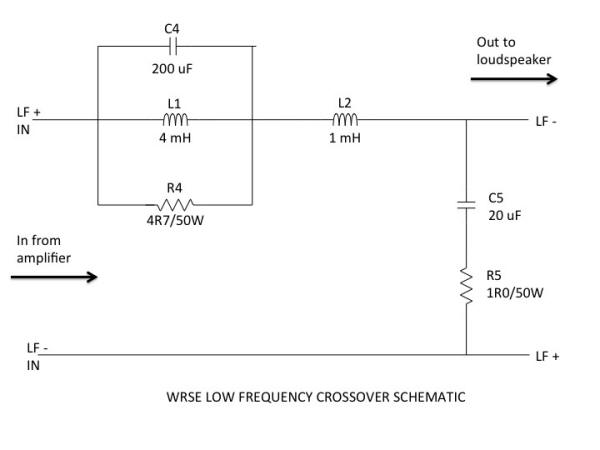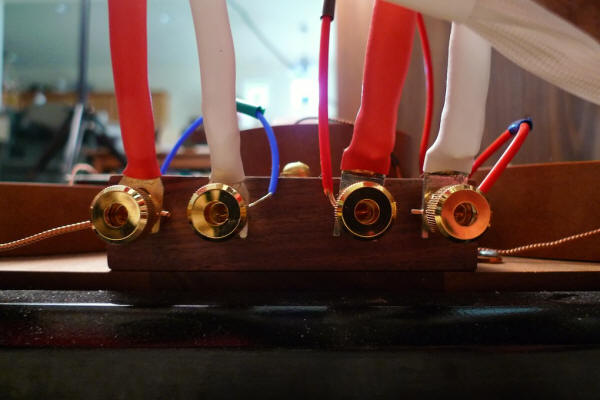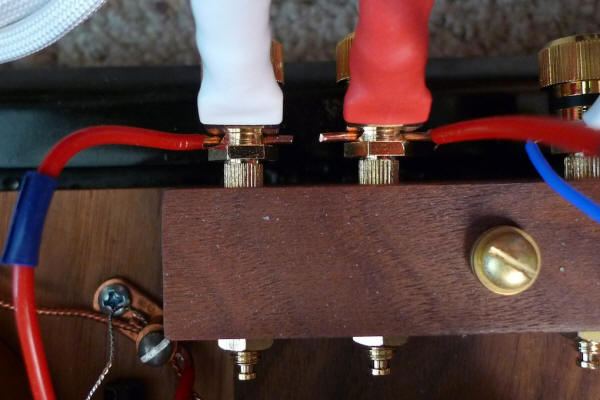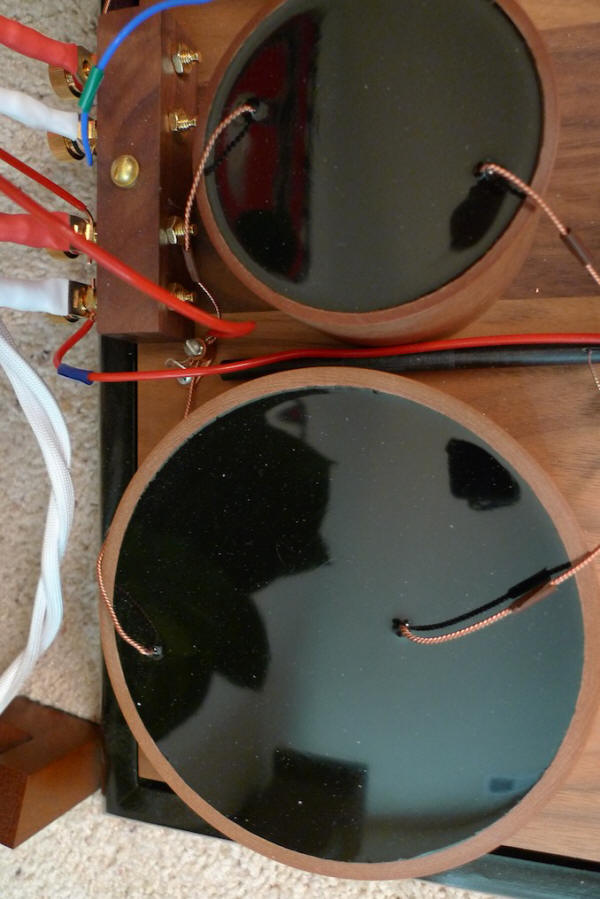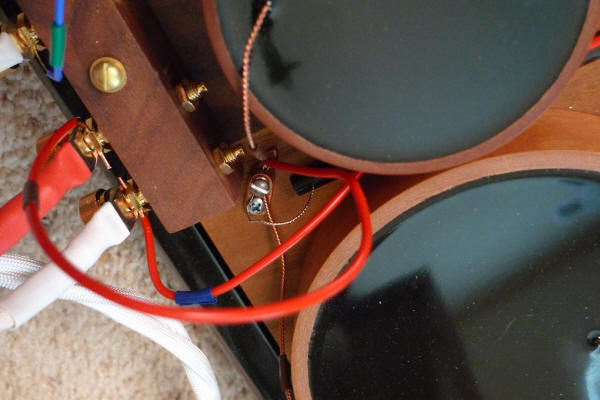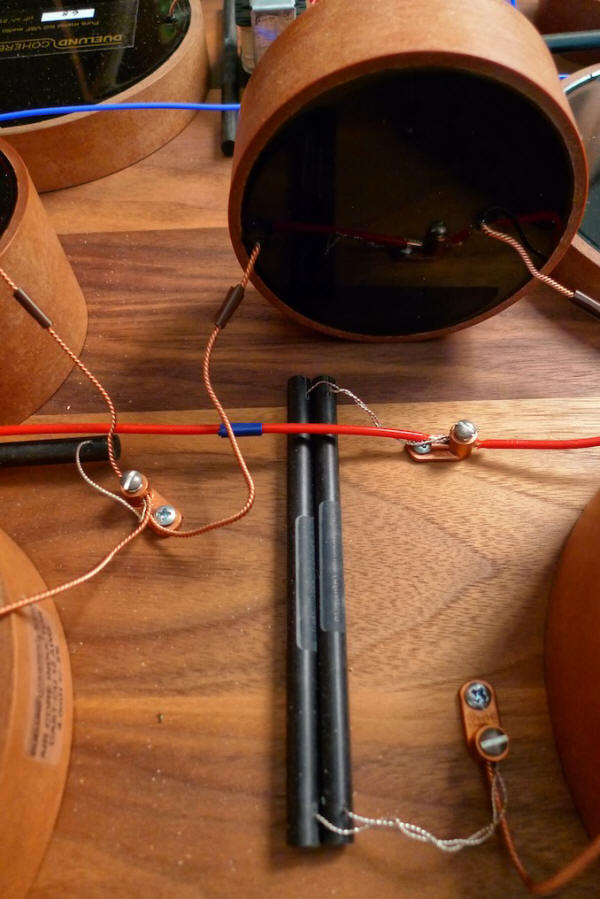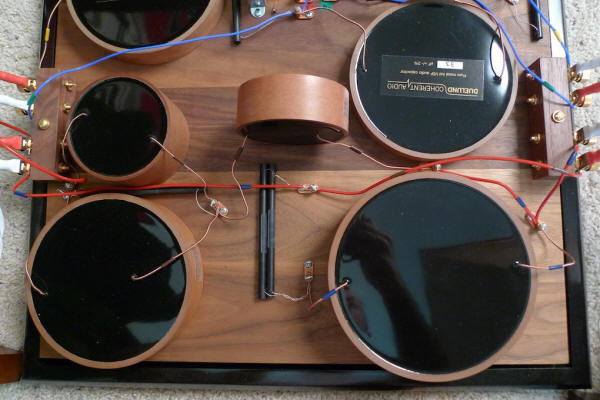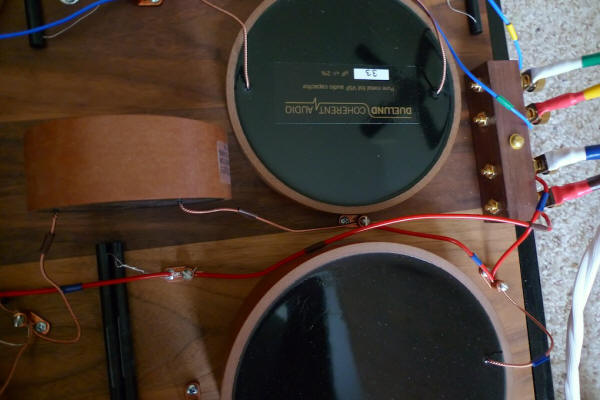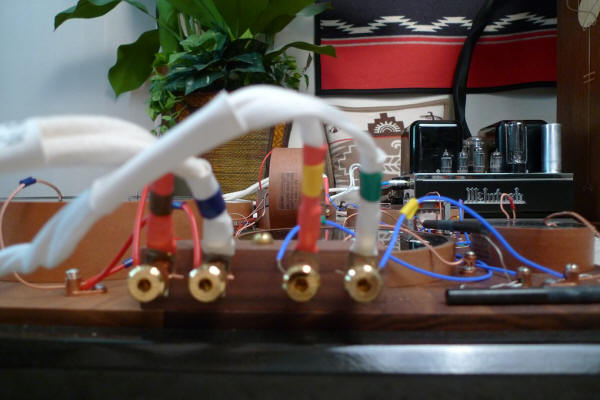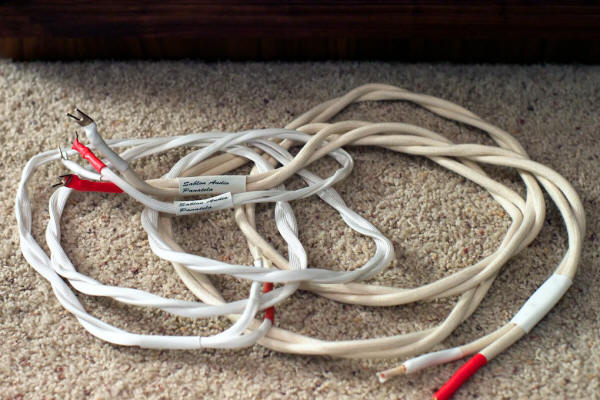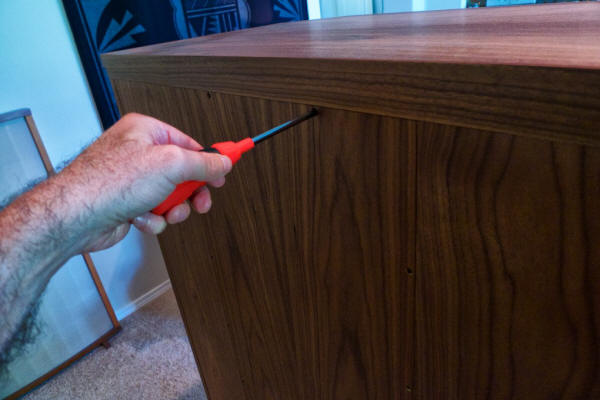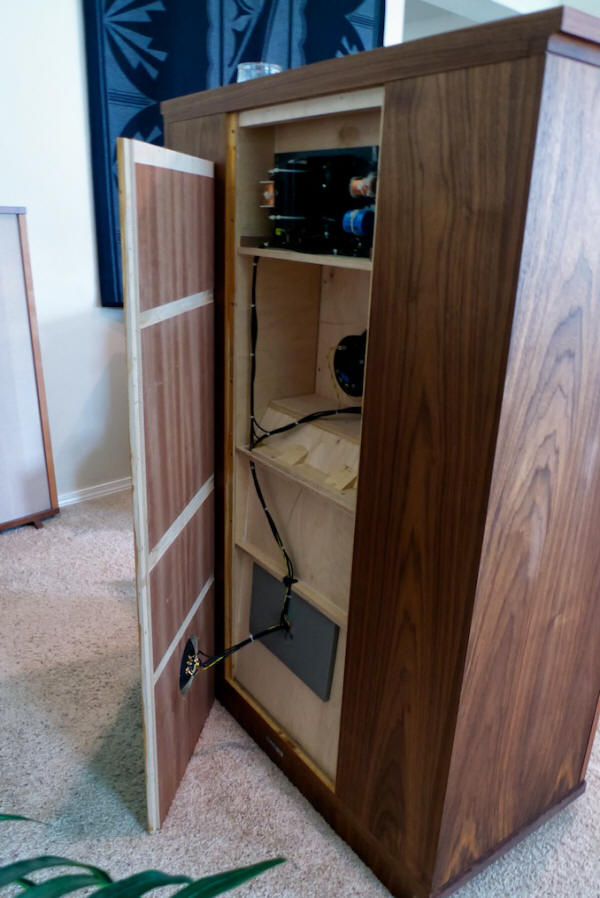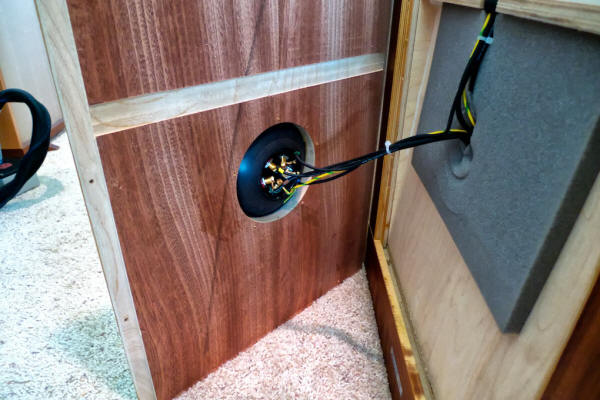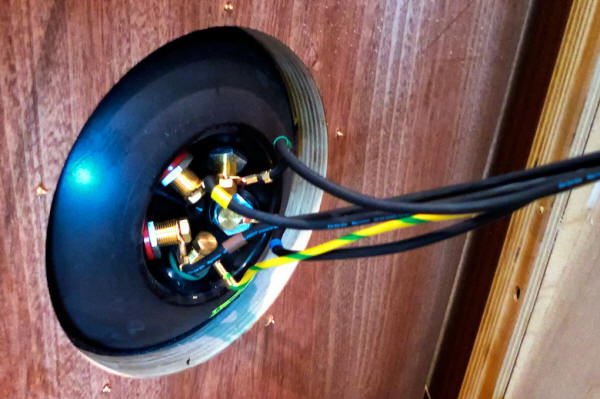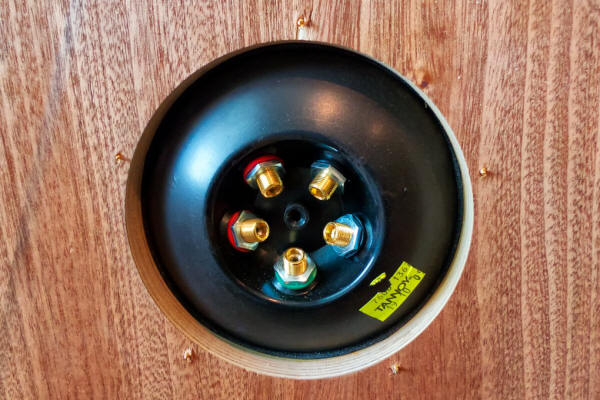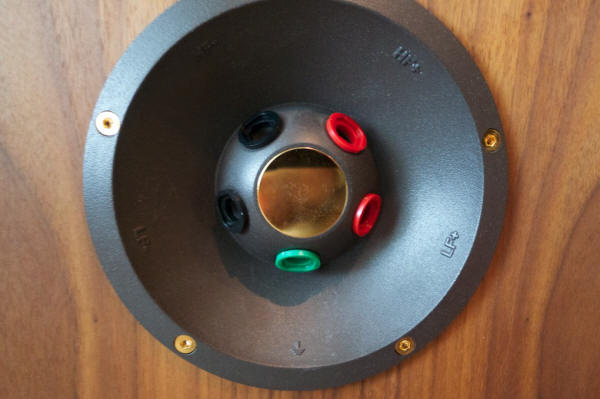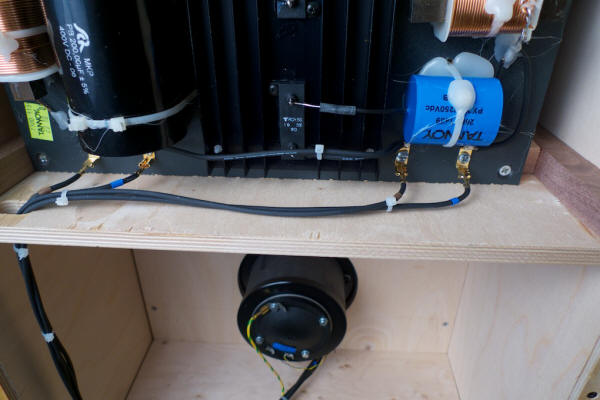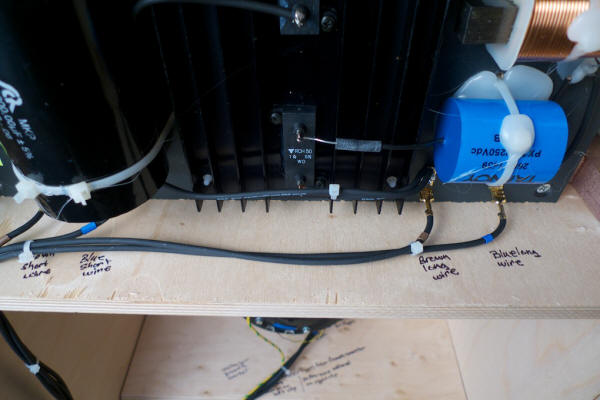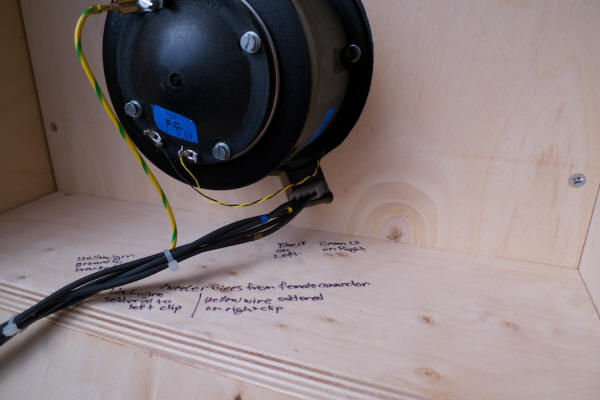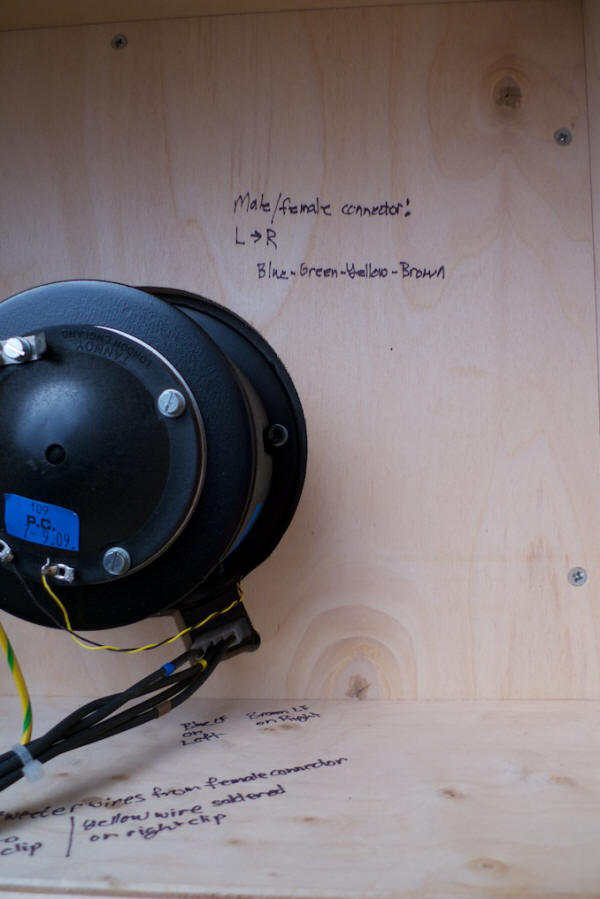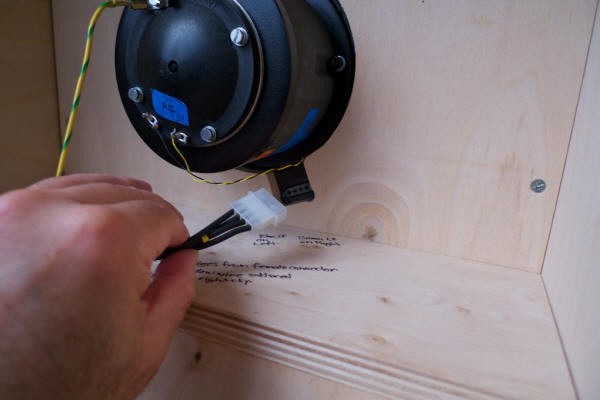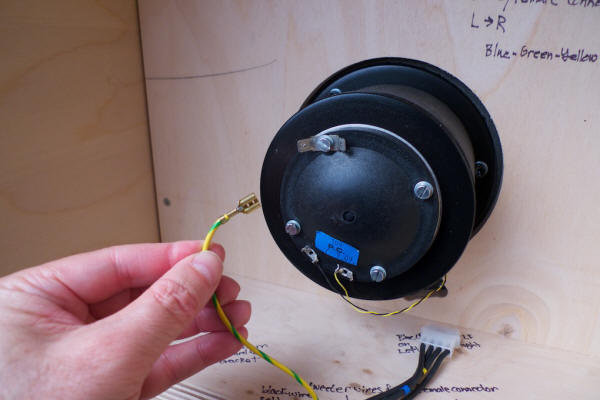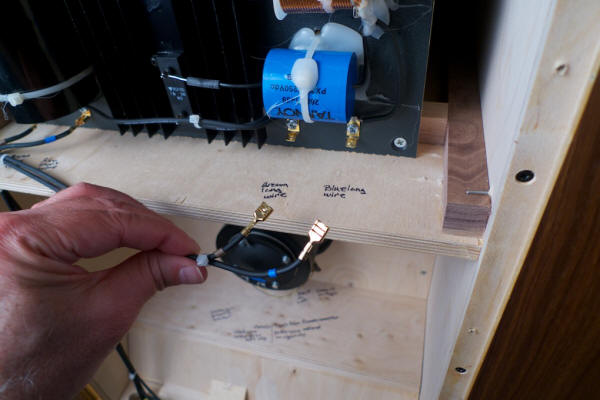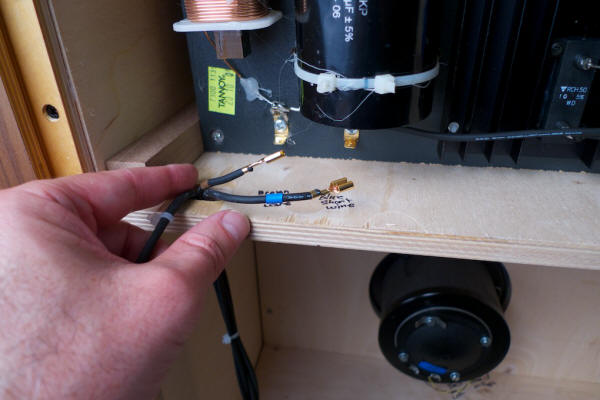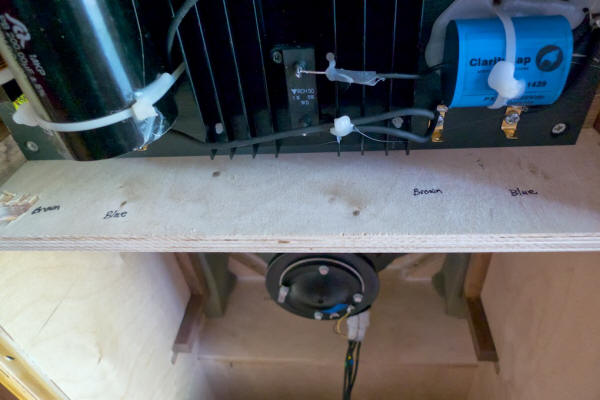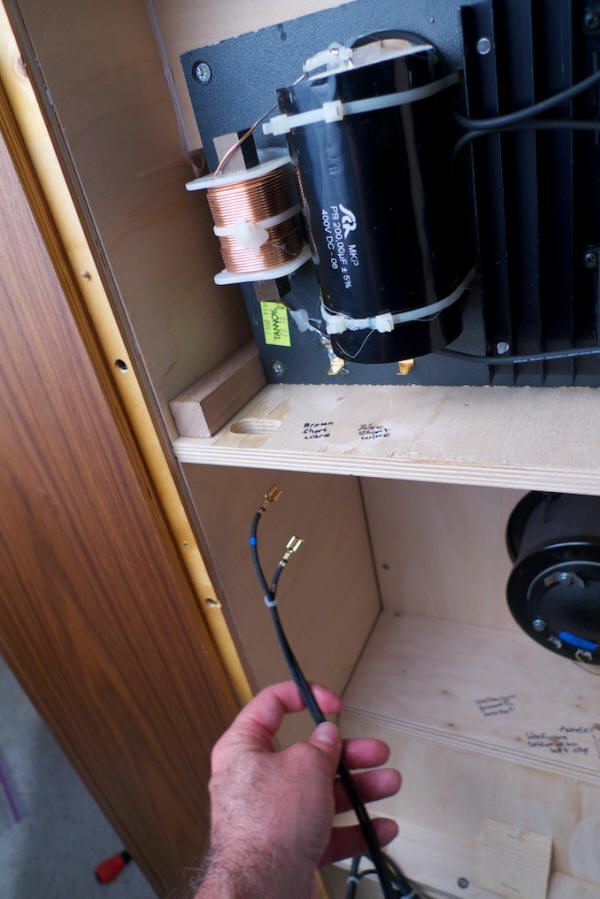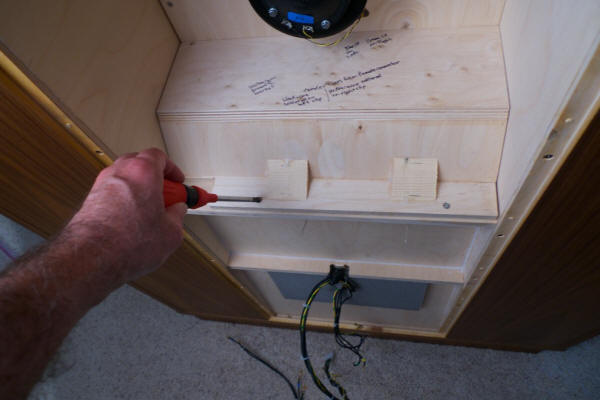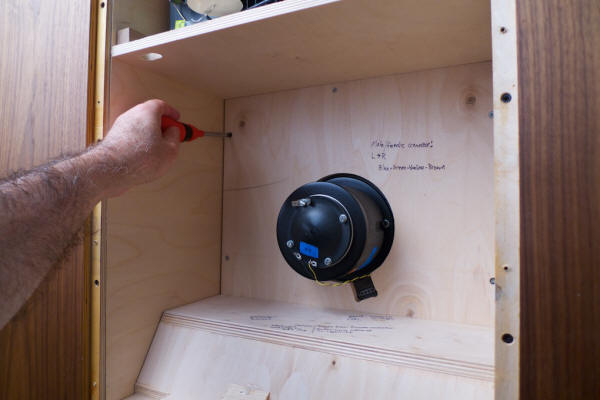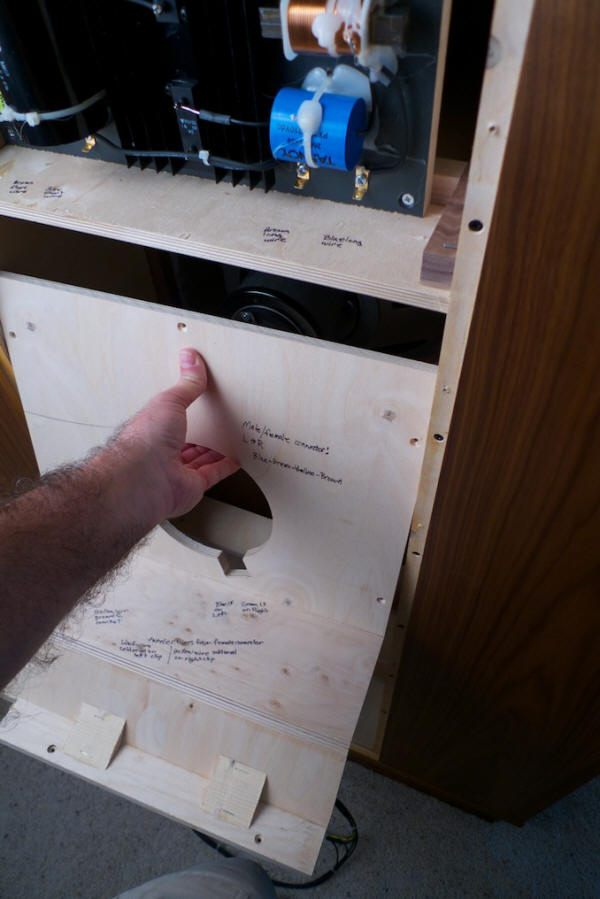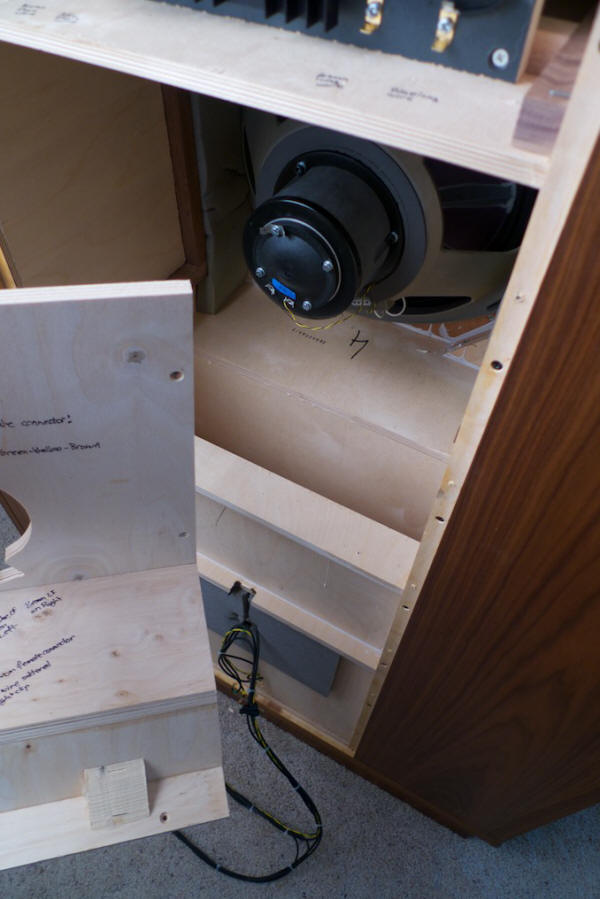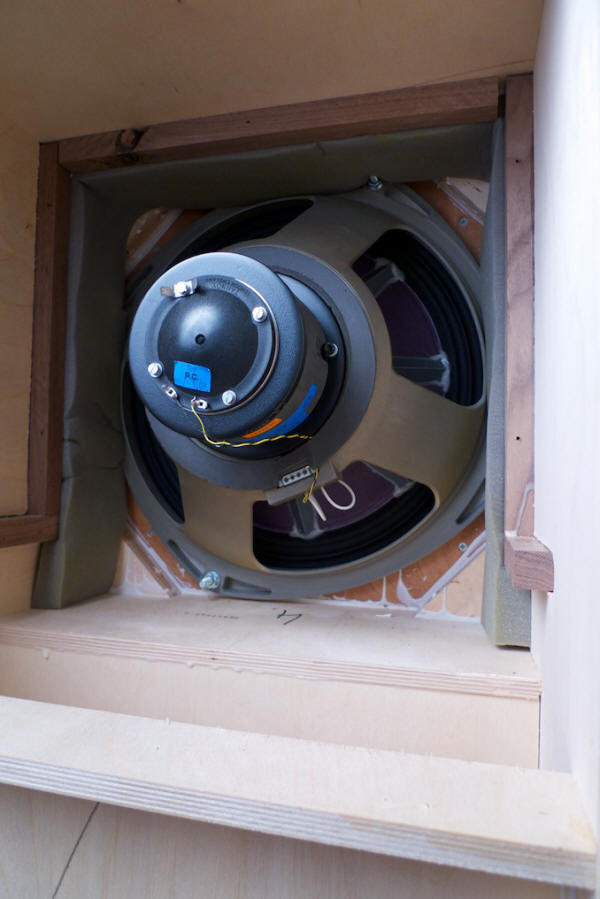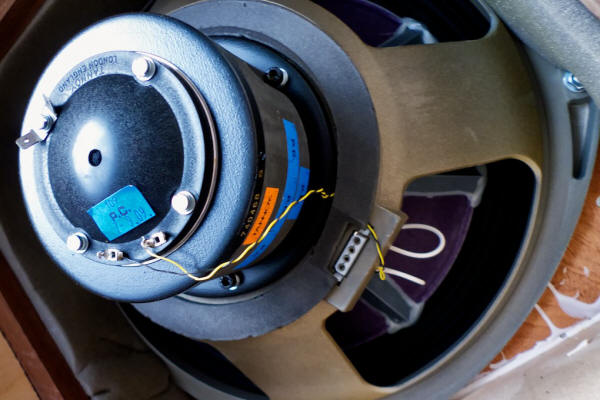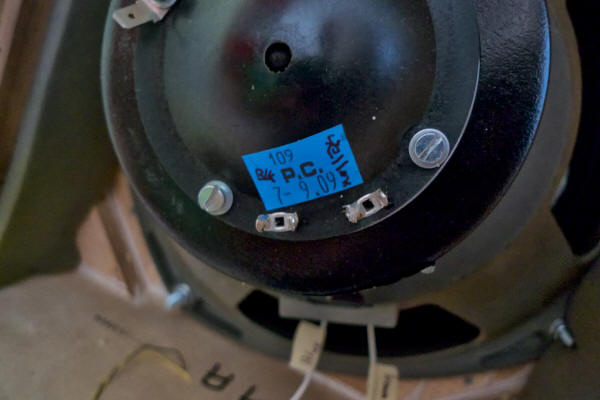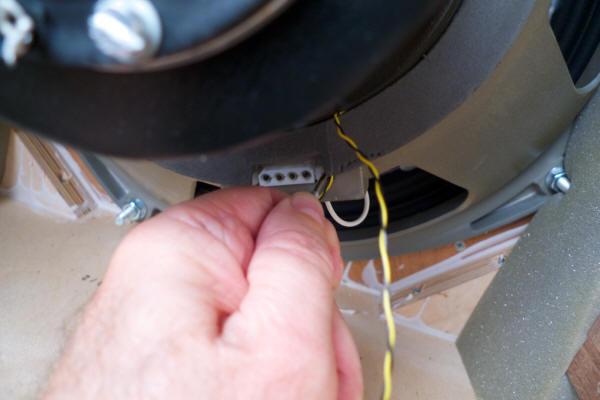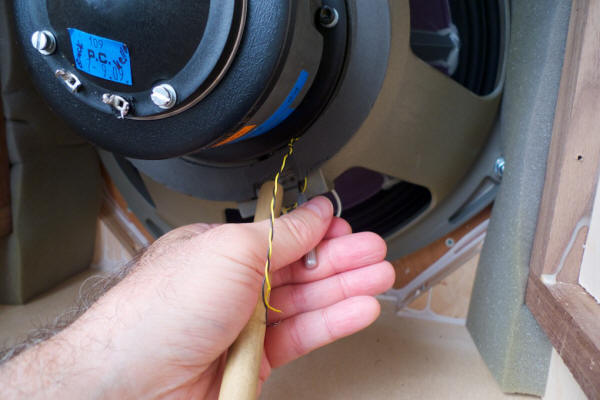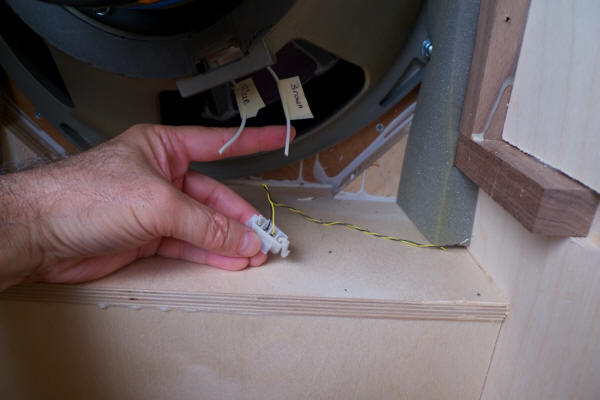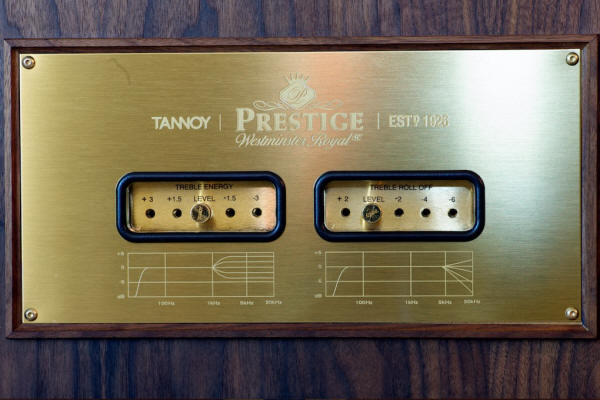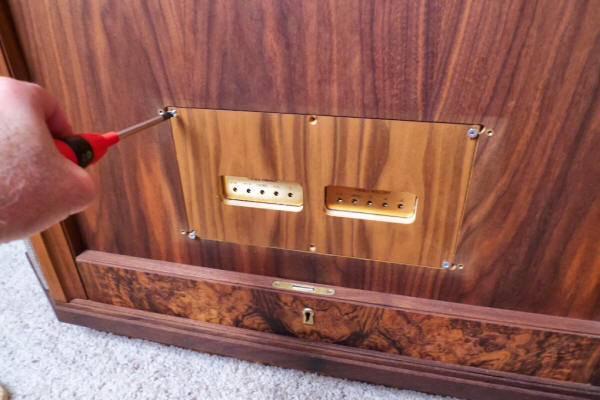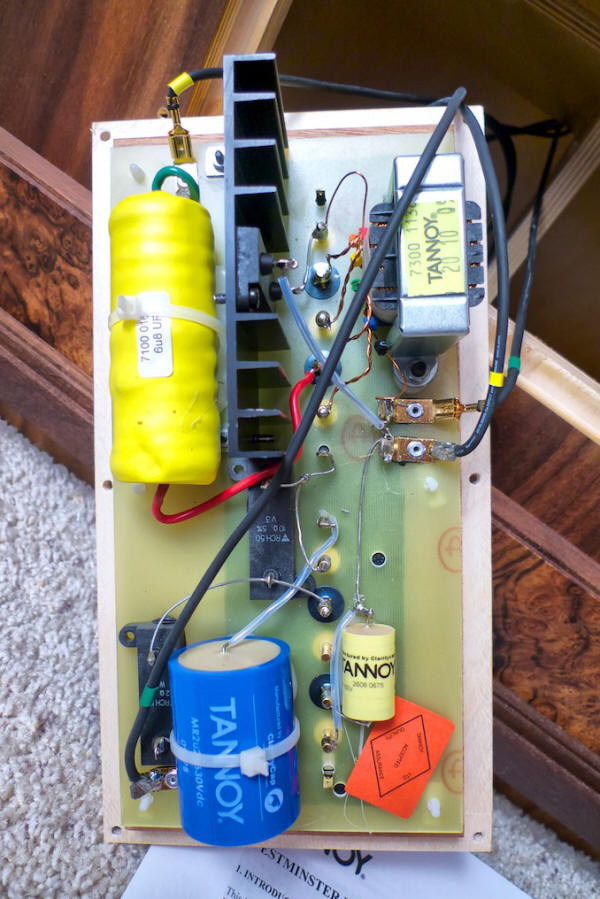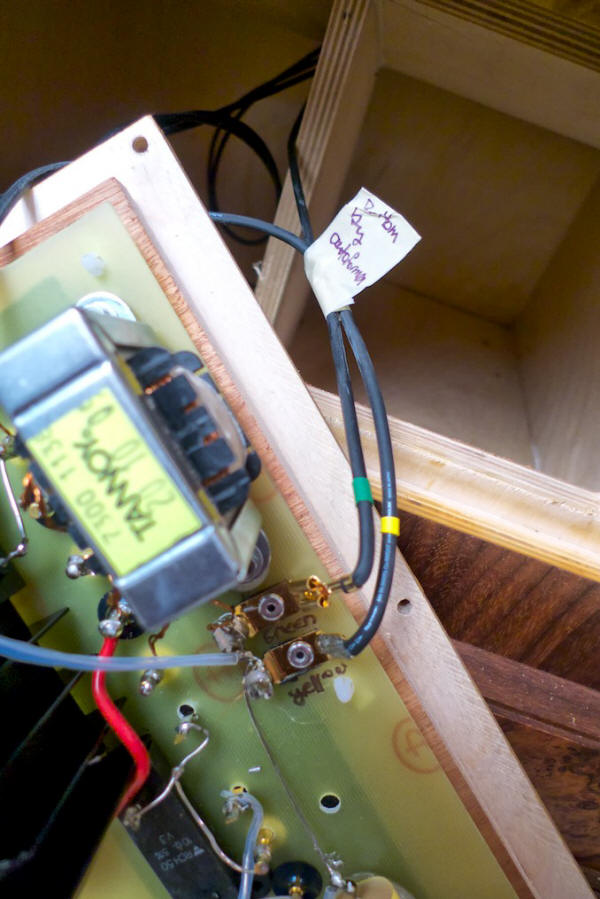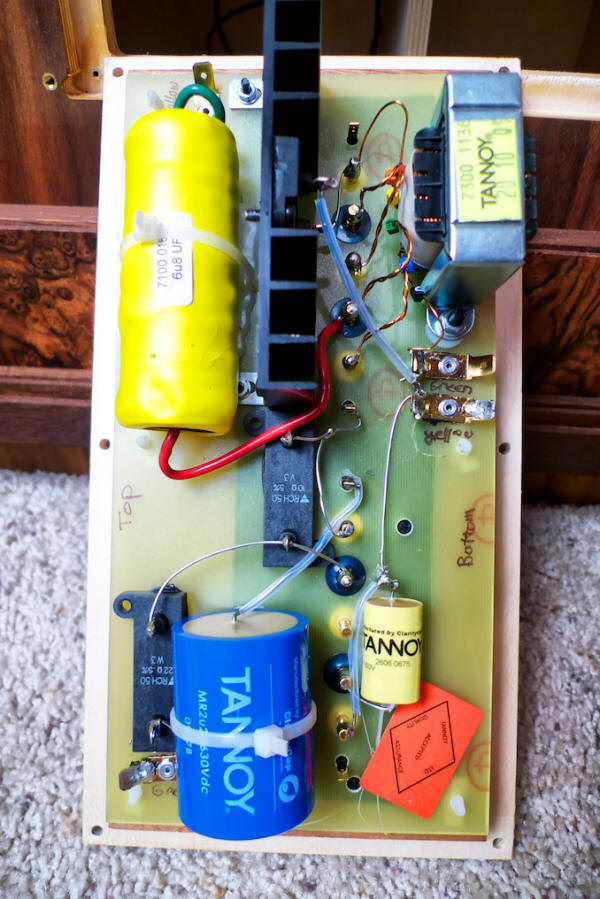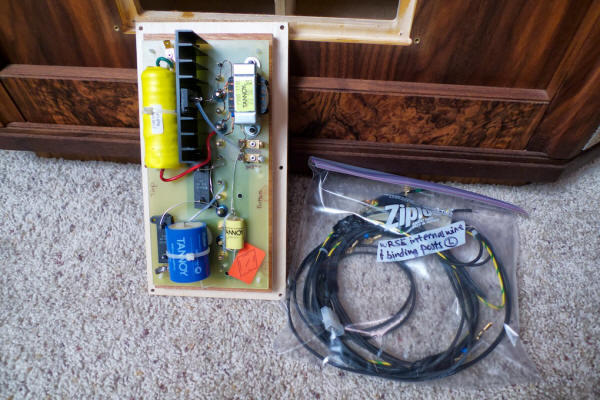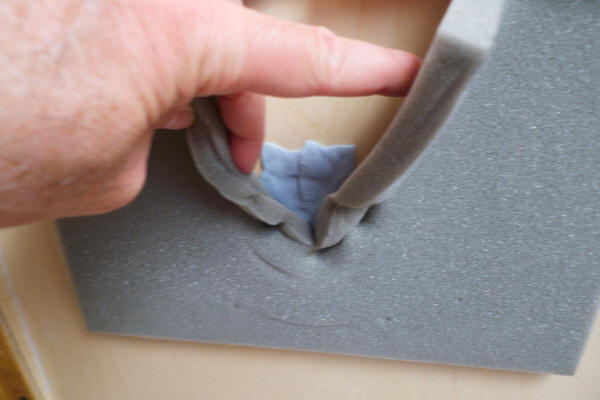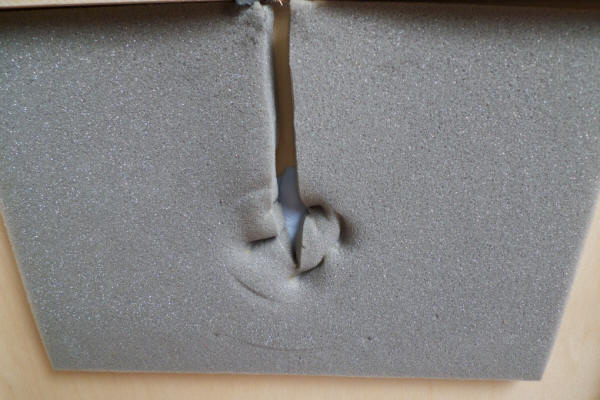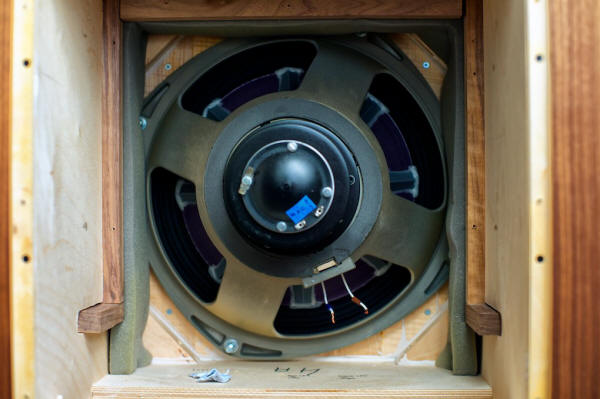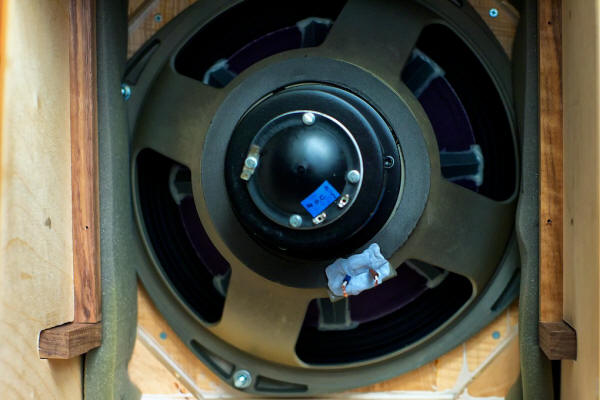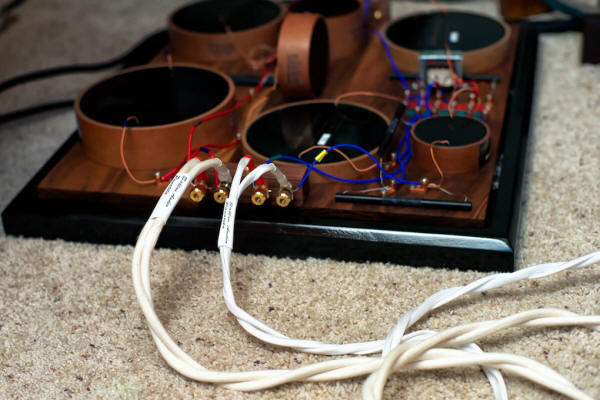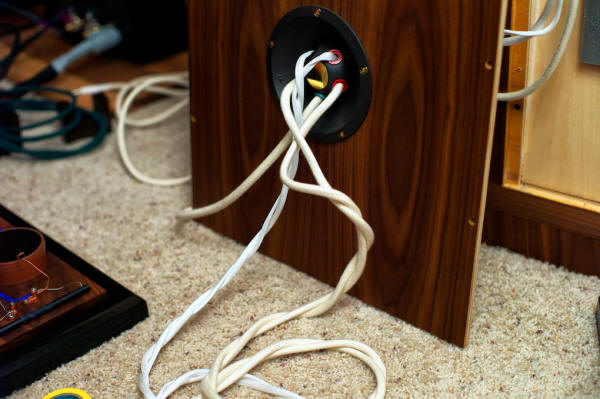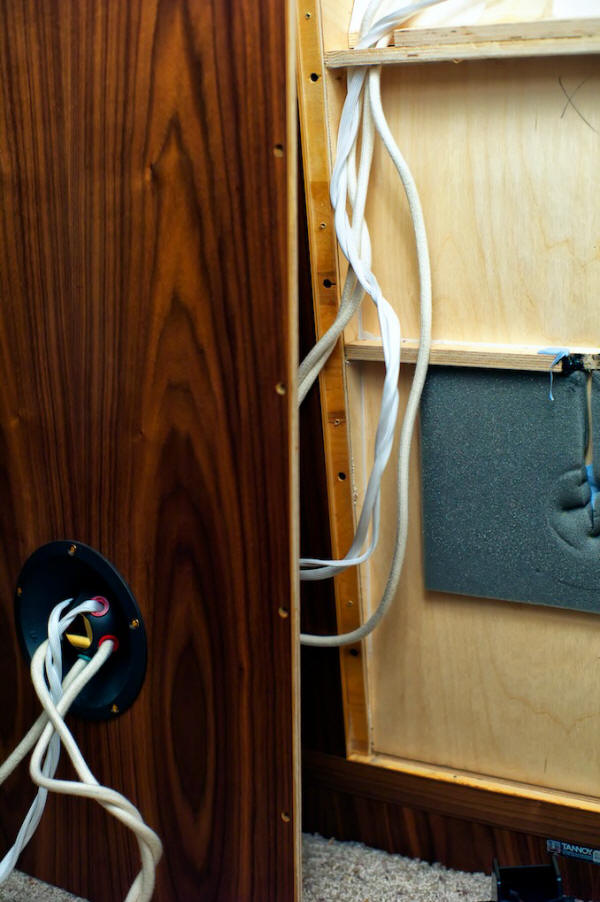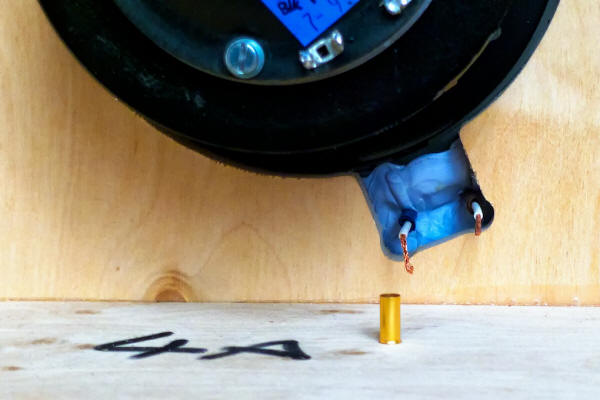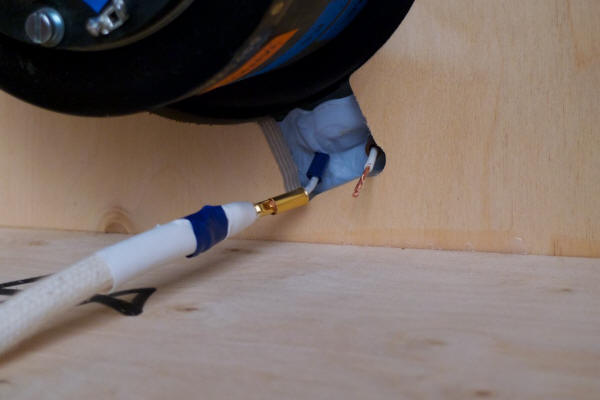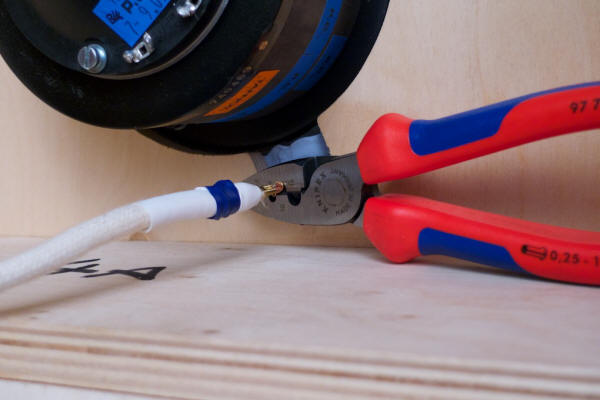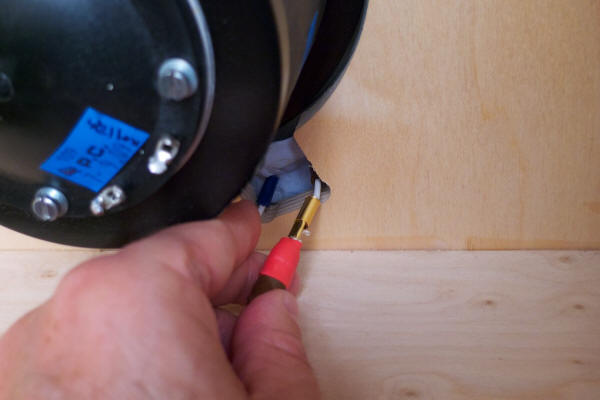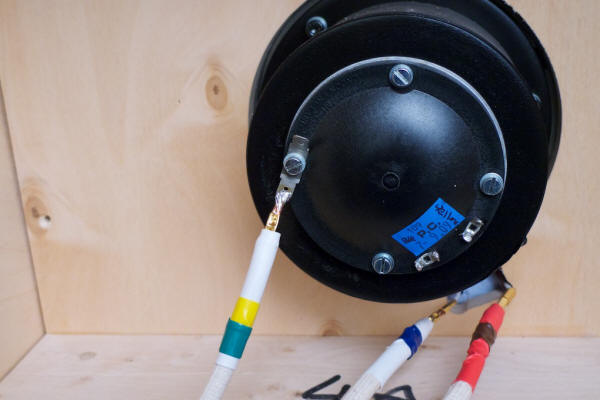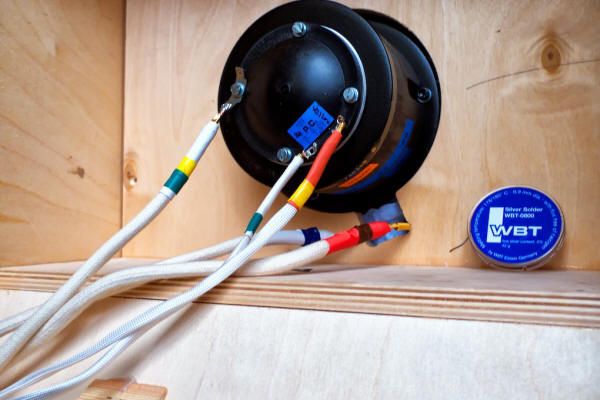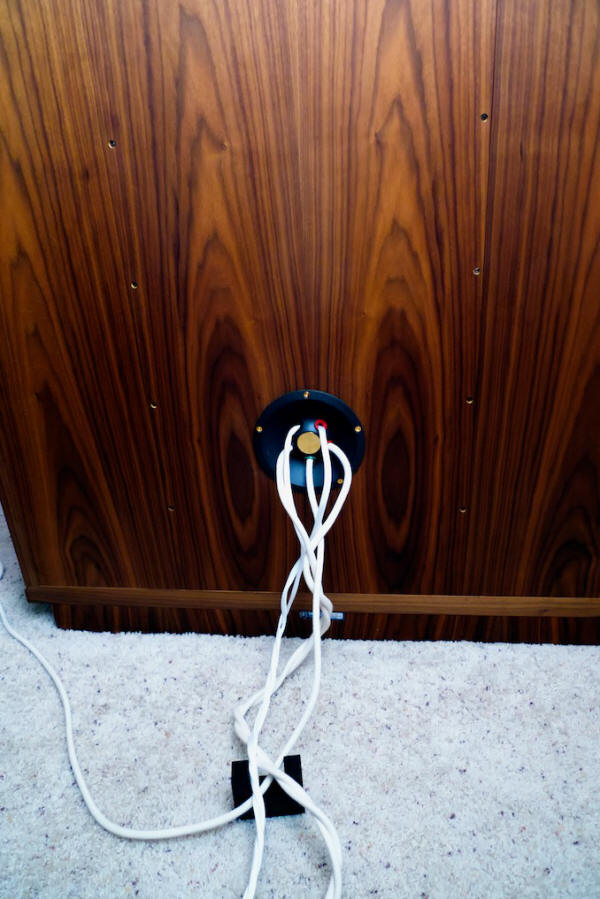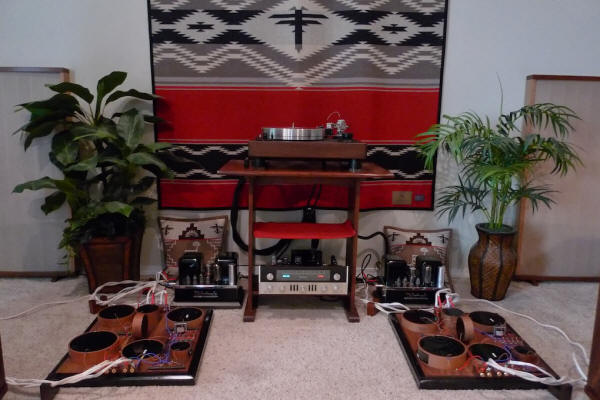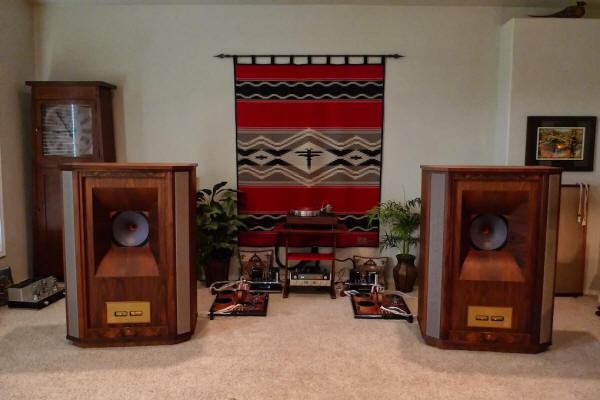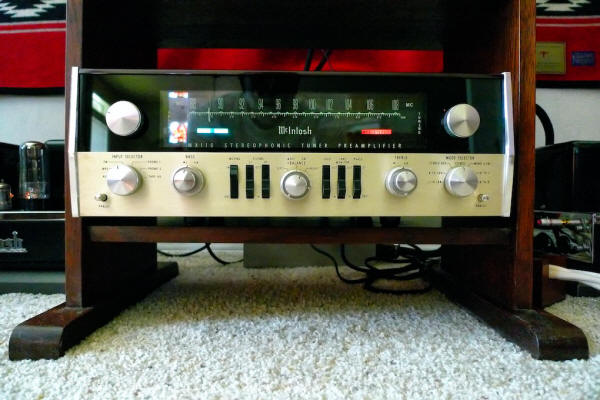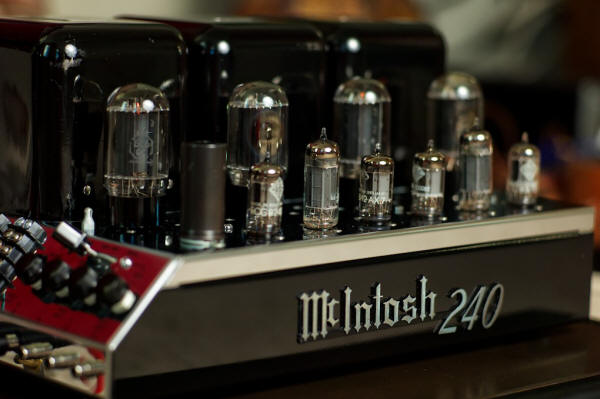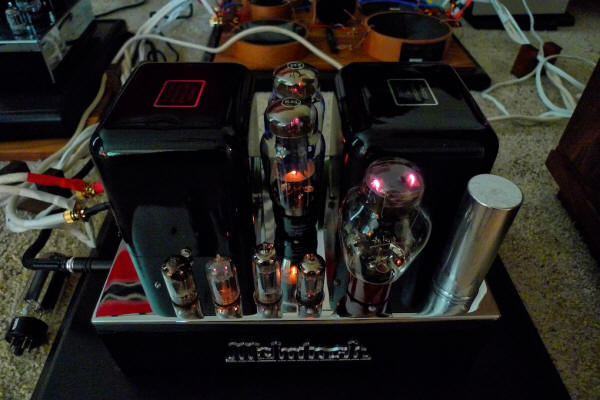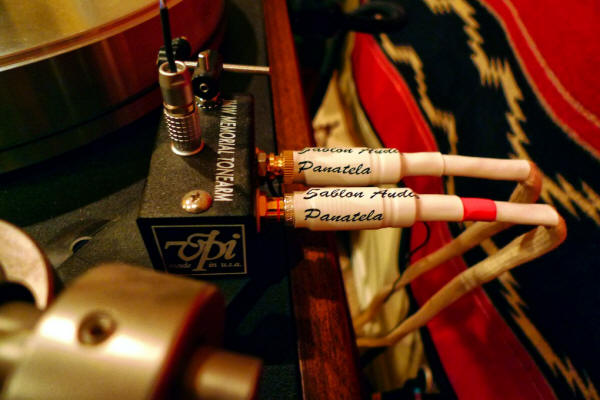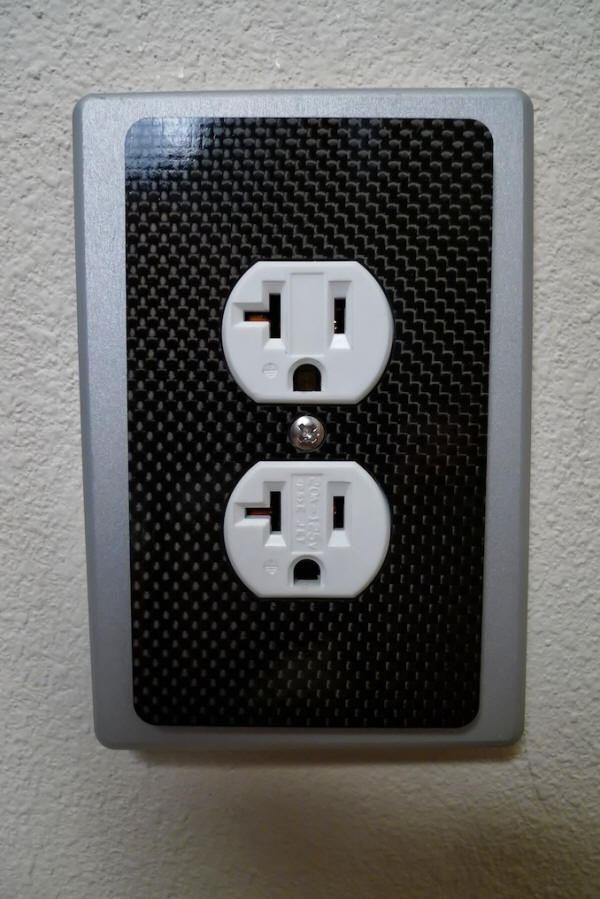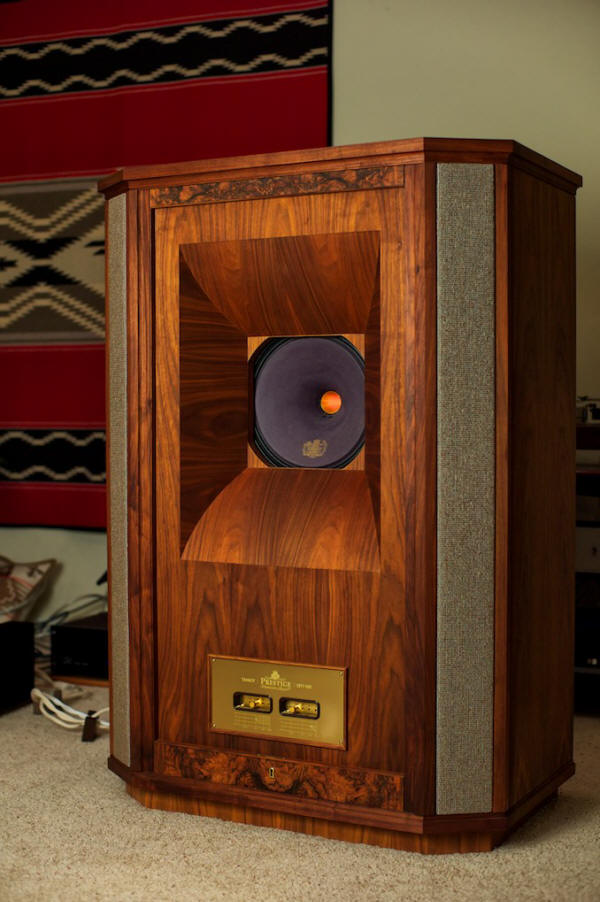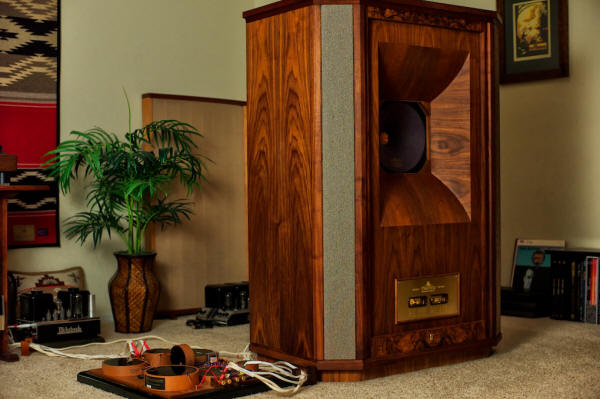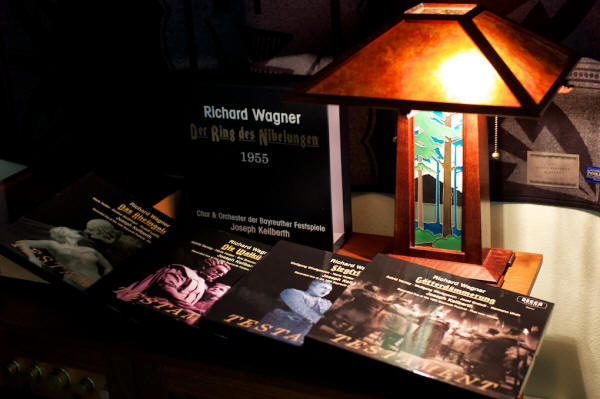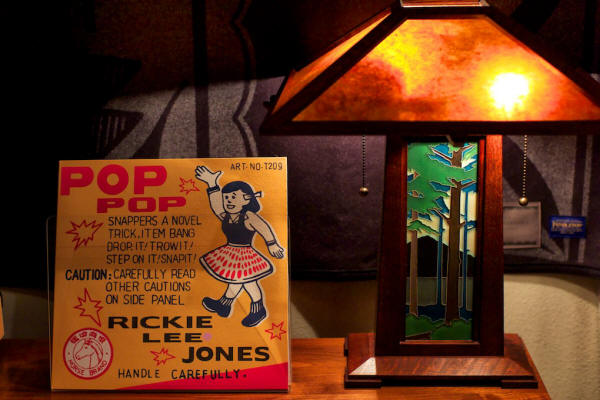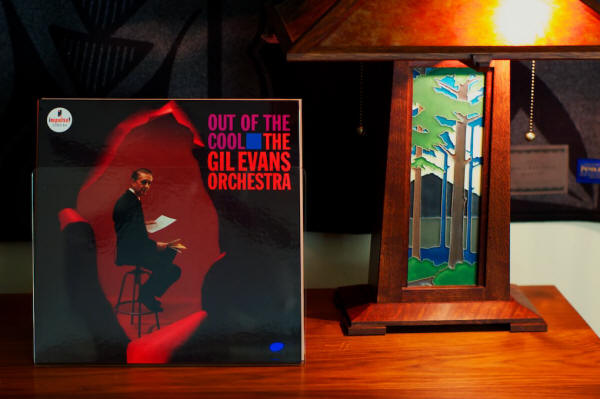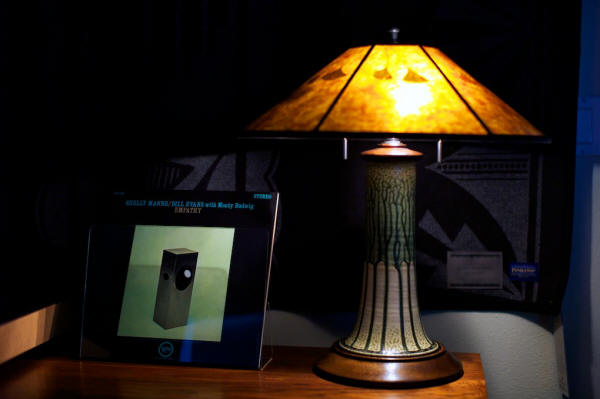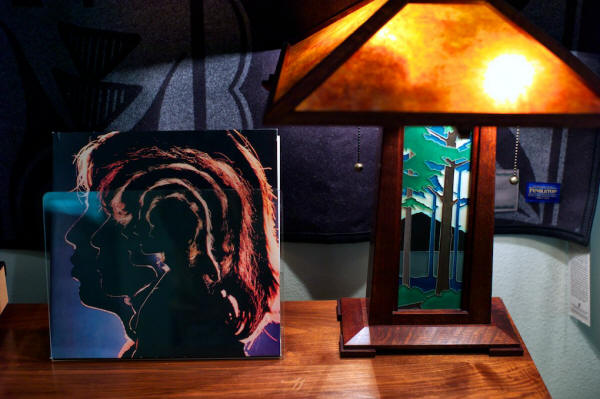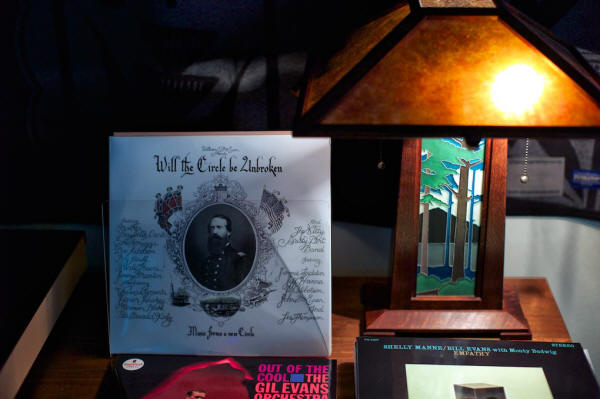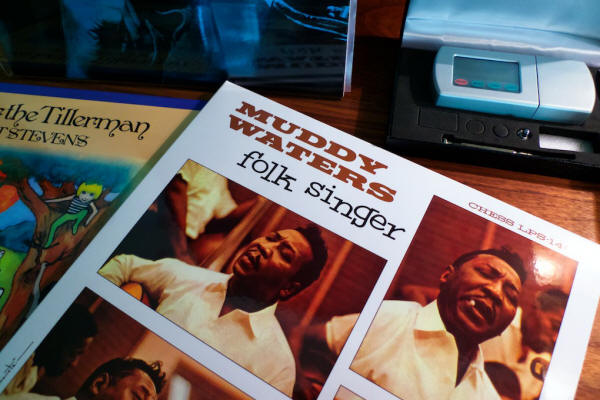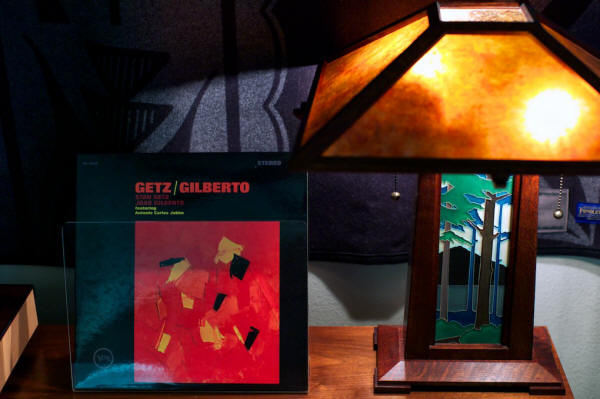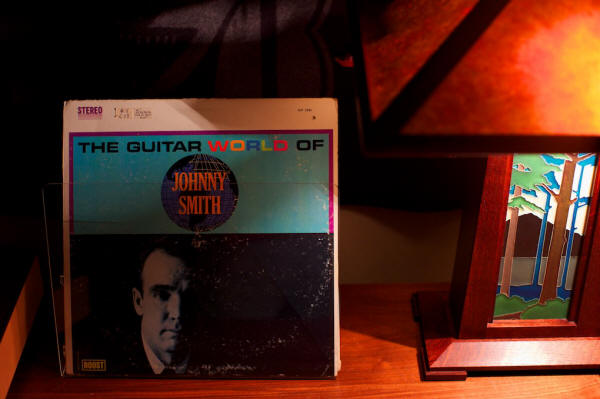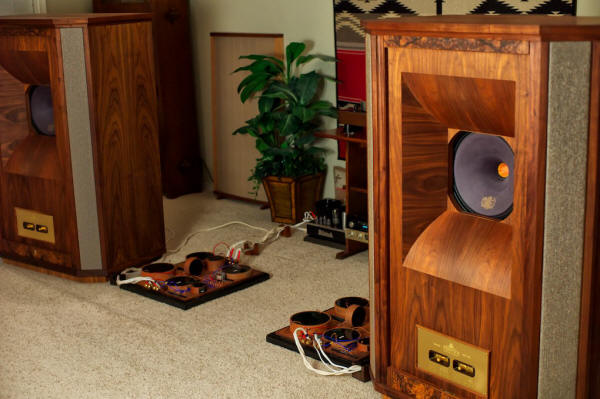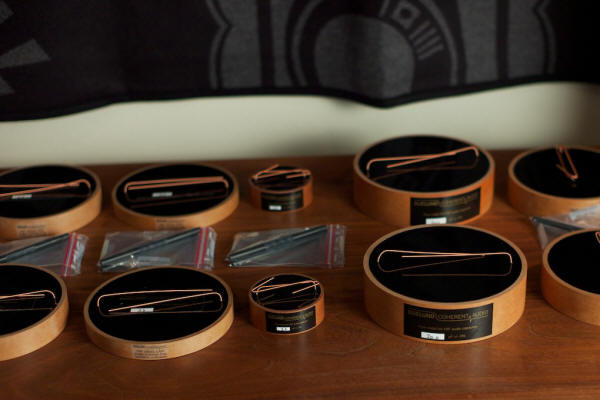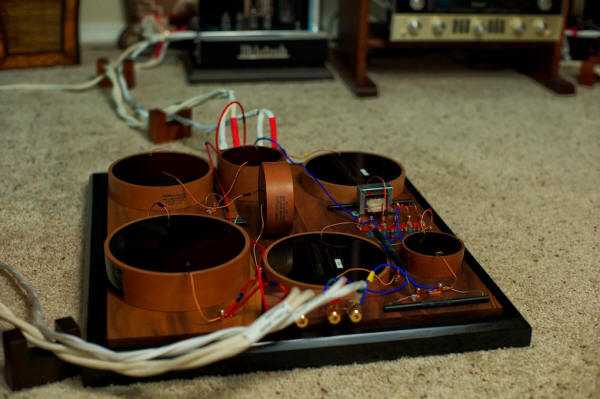You are reading the older HTML site
Positive Feedback ISSUE 70
Duelund Coherent Audio Project - Part 2 A Walk-Through of the Duelund Low-Frequency Crossover The adjustability of the high-frequency crossover makes it more difficult to understand what is occurring in the circuit as different energy & level settings are selected, but fortunately the low-frequency crossover's fixed design makes it relatively easy to follow.
For a refresher, above is the schematic for the low-frequency crossover. We'll start at the left side of the schematic where the signal comes in from the amplifier and work our way across towards the right. In the photo below you can see the pair of LF+/LF- IN binding posts on the right that the Panatela speaker cables coming from the amplifier attach to.
As with the high-frequency binding posts, the low-frequency binding posts also use the bypass method (below) to clamp the 14-gauge Neotech solid-core UP-OCC copper wire (red) used for wiring in the low-frequency crossover to the Panatela speaker cables silver spade connectors.
In the photo below a length of 14-gauge Neotech copper wire goes from the LF+ binding post to a setscrew lug that connects the leads in parallel from the C4 Duelund 200 uF Mylar CAST capacitor (at the top in the photo), the R4 Duelund 4R7/10W Carbon/Silver CAST resistor (between the capacitor & inductor), and the L1 Duelund 4 mH PIO Copper Air Core CAST inductor (at the bottom in the photo).
Below is a close-up photo of the setscrew lug that connects the length of 14-gauge Neotech copper wire from the LF+ binding post to the leads from C4, R4, and L1 in parallel.
In the photo below you can see that on the right side of C4, R4, and L1 there is a setscrew lug that connects their leads in parallel, while adding in the lead for the L2 Duelund 1 mH PIO Copper Air Core CAST inductor, which is visible in the upper right corner of the photograph. The L2 Duelund 1 mH PIO Copper Air Core CAST inductor is positioned perpendicular to the L1 Duelund 4 mH PIO Copper Air Core CAST inductor so their magnetic fields don't interfere with each other.
In the photo above you can also see the two Duelund 2R0/10W Carbon/Silver CAST resistors that are paralleled to give a 1R0 value in the R5 position of the circuit. In the photo below you can see the leads of the paralleled 2R0 Duelund resistors nearest the L2 Duelund 1 mH PIO Copper Air Core CAST inductor connect at a setscrew lug that intersects a length of 14-gauge Neotech copper wire that goes all the way from the LF- IN binding post to the LF+ OUT binding post.
In the photo above you can see that the leads of the paralleled 2R0 Duelund CAST resistors furthest from the L2 Duelund 1 mH PIO Copper Air Core CAST inductor connect at a setscrew lug to the lead from the C5 20 uF Duelund CAST capacitor. The other lead from the C5 20 uF Duelund CAST capacitor connects to the L2 Duelund 1 mH PIO Copper Air Core CAST inductor at the setscrew lug on the far right of the crossover, and a short length of 14-gauge Neotech copper wire connects it to the LF- OUT binding post (see close-up below).
The LF+/LF- OUT to the Westminster connects the 14-gauge Neotech copper wiring of the low-frequency crossover to the Panatela internal wiring using the binding post bypass method, as with the high-frequency crossover (below).
Now that we've completed our 'walk-throughs' of the final versions of the Duelund-WRSE external crossovers, let's get started on the next major project phase, rewiring the Westminster Royals SEs with Sablon Audio Panatela speaker cables so they can get the best from the Duelund CAST external crossovers! Rewiring the Westminster Royal SE Loudspeakers For rewiring the Westminster Royal SE loudspeakers to accept the Duelund CAST external crossovers, Mark Coles was a major source of inspiration on how to best preserve the signal quality coming from the exotic Duelund CAST external crossovers to the WRSEs' Dual Concentric drivers. To that end Mark suggested eliminating the WRSEs' internal wiring connectors, the driver connecting plugs, and the binding posts, which all degrade the audio signal to an extant. At first Mark had recommended that I use the same Neotech wire for the internal wiring of the WRSEs that I had used for the Duelund CAST external crossovers, but after considering the enormous performance improvement I realized with my WRSEs from his Sablon Audio Panatela component speaker cables (which I reviewed in Issue 63 of Positive Feedback Online), Mark suggested we instead use a continuous run of Panatela cables from the Dual Concentric™ drivers to the external Duelund CAST crossovers to see if we could realize a similar performance improvement from using the Panatelas as internal wiring. Let me say that Mark's idea of running a continuous set of Panatela component speaker cables from the drivers to the crossovers really appealed to me, and it turned out to be a complete success. While the primary focus of this article is upon the remarkable performance improvement that can be realized by using the Duelund CAST components in the external crossovers for the WRSEs, I want to emphasize that to fully benefit from the Duelund CASTs' lofty performance potential you'll want to use the absolute best internal wiring possible, and for my Westminster Royal SE loudspeakers that's the Panatela speaker cables that Mark has tailored to perfection to match their performance needs. To get an idea of the sort of performance you can expect by using the Panatela component cabling in the Westminster Royals SEs, I recommend that you go back and read the Panatela review in Issue 63 of Positive Feedback Online where I covered it in detail. Here is a snippet about the Panatela's performance from that review: "The Panatela had a rich, luxurious, slightly warm & dark presentation, which at the same time was extremely transparent and high resolution, which I find to be a rather amazing set of qualities, as usually you can have one or the other but not both. This 'darkly detailed' style of presentation is my personal audio Holy Grail, because it not only portrays a musical performance as emotionally engaging, but also as spectacular sonically, which provided an unbeatable combination that left me in an almost constant state of musical satisfaction and amazement. The Panatela speaker cables portrayed timbral characteristics like textures, colors, and tones & overtones superbly, and in my experience the Panatela is in a class by itself in this regard. The string tone and color in Swan Lake was so naturally & compellingly portrayed that it left me in a state of awe as to its beauty and ability to stimulate an emotive response. The same with Getz/Gilberto, where instrumental timbres (piano, guitar, sax, drums and bass) and Astrud's & Joao's vocals were so beautifully tangible and present that it was intoxicating. One of the strengths of the Panatela is being able to unravel complex music, like classical music, and present it in its full sophisticated glory. In this regard I think the Panatela speaker cables have no rival. Listen to any one of the Ansermet recordings and I suspect you'll be picking your jaw up off the floor even as I did. This level of musicality combined with this level of sonic sophistication is unrivaled in my experience." I was completely blown away by the performance improvement the Panatelas brought to my Westminsters during the review, and using them as internal wiring for the Westminsters yielded similar results times two. Using the Panatela component speaker cables as the internal wiring for the WRSEs was a truly exciting development in the project, and I'd like to thank Mark Coles for suggesting it and providing a set of Panatela component cables to use for the project. As we get ready to move on, let me remind you what goes into producing a set of Panatelas. Mark custom makes every set of Panatela cables, and builds them up from the bare wire. Mark meticulously voices the Panatela cables using a variety of different conductors and natural dielectrics. As I mentioned in the review, Mark contacted Dr. Paul Mills at Tannoy and got his advice about optimizing the high-frequency Panatela cable run to match the Tannoys Dual Concentric™ high-frequency driver characteristics. Mark doesn't use solder joints that degrade the sound, he uses great connectors, and he meticulously tweaks the design with cryo treatments, anti-oxidants, contact paste and the like. To top it off Mark pre-conditions all of his Panatela cables with an audiodharma Cable Cooker so there's no break-in required. Mark's approach to making the Panatela cables utilizes the same sort of dedication to perfection as Frederik & Magnus do with their Duelund CAST components, and due to my aforementioned experience I felt confident that Mark's Panatelas would bring out the very best in the exotic Duelund CAST components. To say I was very excited about the opportunity to use the Panatela component speaker cables as the internal wiring of the WRSEs would be a massive understatement!
The Panatelas I used for the internal WRSE wiring part of the Duelund-WRSE Project were the very pair of 8-foot Panatela speaker cables I reviewed for Positive Feedback Online back in Issue 63, which Mark Coles repurposed for use as internal wiring by reterminating one end of the Panatela speaker cables to make them suitable to connect directly WRSE's Dual Concentric™ drivers. If you decide you want to use Panatelas as internal wiring in your own Duelund-WRSE external crossover project—and I would recommend that—Mark will make you a set of Panatela cables as a custom order to meet your specific needs. Mark told me that the cost would be similar to that of the Panatela speaker cables as they are "the same underlying product with different terminations". You should contact Mark directly for accurate price quotes on the best length of Panatelas for your project. To give you an idea of what you're looking at price-wise to duplicate what I did for this project, the 8-foot pair of Panatela speaker cables used from the low-frequency section of the Dual Concentric™ drivers to the low-frequency section of the external Duelund crossovers retails for $1750 USD. The pair of 8-foot Panatela tweeter cables going from the high-frequency section of the Dual Concentric™ drivers to the high-frequency section of the Duelund external crossovers retails for $1250 USD, and Mark also made me a set of dedicated ground leads to go from the ground on the Dual Concentric™ drivers to the ground on my restored vintage McIntosh MC240/MC30s, which retails for $375 USD. Total Panatela internal wiring cost comes to $3375 USD for an 8-foot set. I used an 8-feet length of Panatela component cables to provide flexibility for reviewing, so that I could easily move the Duelund CAST external crossovers around to accommodate various electronics during reviews, and also so I could keep them visible during photo shoots. If you have a fixed system you can get by with shorter lengths of cable. For example, Frank Rogers, a fellow Westminster Royale SE enthusiast who has also done the Duelund-WRSE project for his loudspeakers, told me he successfully used a 5-foot set of Panatelas and that length worked great. Frank also told me he thought he might have got by with a 4-foot set had he placed his crossovers directly behind the loudspeakers. If you decide you want to do a project like this, I thought it would be handy for you to see every step in the process, so lets go through what I did in detail to rewire my Westminster Royal SEs.
The first step is to open up the big Westminsters by removing the back panel screws with a # 2 Philips screwdriver. After taking out the screws and setting them aside I lifted out the back panel and set it down against the cabinet. Caution: My back panel came out easy, but Tannoy says the back panel is often a tight fit and warns that owners should not try to pry it out or you could damage the cabinet. Rather, Tannoy says to instead go around the outside of the panel while "thumping it firmly with your fist" until it starts to loosen up and move, then you can lift it out. Good advice to follow to protect your precious WRSEs.
Closer view…
Closer view still…
The next step is to remove the WRSEs' internal wires from the speaker binding posts mounted in the terminal panel. The internal wires are held to the binding posts with 8mm bolts, so I first loosened the bolts with a 8mm wrench, and then removed the 8mm bolts with a socket to speed the job.
Once the bolts and internal wires were removed, I then removed the nuts holding the binding posts in place, and then removed the binding posts from the terminal panel, allowing me to set the back panel aside to give myself more room to work on the WRSEs internals. When the binding posts have been removed from the terminal panel the mounting holes are just the right size to thread the Panatela cables through when the time comes!
Hint: Before you start unplugging the wiring from the drivers and low-frequency crossovers, be sure to label everything just in case! I wrote directly on the wood inside my Westminster Royal SEs' cabinets with a Sharpie® to make it clear what went where for future reference.
Label the low-frequency crossover according to the wiring color code conventions!
Next I labeled the harness color codes on the inside of the cabinet, as well as the position of the tweeter wires and grounds.
Another view...
Next I unplugged the drive unit wiring harness male connector from the female connector. It just pulls straight out. The color-coding scheme Tannoy uses for the internal wiring follows this convention: Brown: LF +ve Blue: LF –ve Yellow: HF +ve Green: HF –ve (this wire is black from the female connector to the driver) Green/yellow: Earth
Next unplug the yellow/green ground wire.
Then unplug the four wires from the low frequency crossover.
Next I pulled the wires down through their routing holes to get them out of the way for the next steps.
I pulled the wires down through the second routing hole too and let the wire harness rest on the floor. Next I removed the screws that hold the internal plywood structure that seals the bass horn in place with a # 2 Phillips screwdriver. There's two screws as seen in the photo below and…
…then I removed the 5 screws from around the driver of the internal plywood structure that seals the bass horn.
Next I lifted out the internal structure to expose the driver, and then set the inner structure aside.
I'll connect the internal Panatela wiring direct to the drivers, and then direct to the outputs of the crossover, so I will not be using the stock Tannoy male/female plug connectors, which are said to degrade the sound quality. That way I have only the Panatela wiring in the signal path between the crossovers' outputs and the driver connections with no intervening connectors.
There are two extremely fine wires that go from the female plug connector to the tweeter. There's a little blue tag on the tweeter endcap, and I suggest that if you're doing a direct connection of wire to the tweeter driver like I am, that you label it with the wire connection's color codes. Mine had a yellow wire connected on the right, and a black wire connected on the left. The wires are soldered in place, so I snipped them off to get them out of the way. Caution: If you choose to desolder / solder the connections for the high frequency wires you need to be extremely quick and cautious about it. The two tabs that the yellow & black high frequency wires are attached / soldered to are mounted on a driver endcap that is made of plastic (the one in the photo with the 4 screws holding it in place). If you heat the tabs too long with a soldering iron you'll melt the plastic. This could wreck your day as the endcap has micro-electrical connections deposited in it in high-tech fashion, and it is part of the tweeter assembly. If you melt it you will likely destroy it. That means you'll have to order new ones. They're probably expensive. Be careful!
Then I removed the female plug connector from drivers frame. The connector has two little plastic prongs that you have to push in to get clearance so you can push it out (I used a small screwdriver).
Then I pulled the fine tweeter wires through to free them from the opening. I then pushed the female connector out using the handle end of a wooden spoon (use something non-magnetic or it'll be drawn into the powerful magnet of the driver, which is a no-no). Note the color-coding and label the wires. Mine had blue (LF -) as the left wire and brown (LF +) as the right wire.
Now it was time to go to work on the high frequency crossover located in the front of the Westminster's cabinet. On the front of the cabinet I removed the 2 brass adjustment screws and set them aside.
I then removed the four 2.5mm hex screws holding the brass trim place in place, pulled out the plastic cups, and then removed the trim plate and set it aside.
I then removed the 6 wood screws holding the wooden panel and withdrew it to reveal the HF crossover assembly.
I marked the yellow (soldered) and green (press fit) positions on the circuit board by the autoformer with a permanent marker in case I wanted to re-install the stock cable set, so I could remember what went where. I taped the green and yellow wires together and labeled them "bottom by the autotransformer".
I unplugged the green wire from the circuit board, and then I de-soldered the yellow wire. I then labeled the green (soldered) and yellow (press fit) positions on the top of the circuit board with a permanent marker, and then de-soldered the green wire and unplugged the yellow wire. I taped the two wires together and labeled them "top of the circuit board".
I then pulled the internal wiring harness out through the back of the speaker and placed it in a plastic bag labeled "WRSE internal wire & binding posts Left" and set it aside in case I need it later.
I reinstalled the now disconnected HF crossover back into the cabinet, put back on the trim plate, inserted the plastic cups, and put the selector pins back in place. I then went around back and sealed the wiring harness hole in the back of the horn with Blu-Tack.
Another photo.
I labeled the wires with the Peavey color-coded microphone tape so I wouldn't get them mixed up.
I then pulled the low-frequency wires through the connector hole and then sealed the hole with Blu-Tack. Then I set the internal plywood structure that seals the bass horn and the driver back in place.
The Panatela low & high-frequency cables sets are shrink wrapped on the crossover end, so I reverse routed them from the external Duelund crossover through the binding post holes in the Westminster Royal SEs.
Through the binding post holes in the Westminster Royal SEs…
…and up through the cabinet routing channels.
As a refresher, the color-coding scheme Tannoy uses for the internal wiring follows this convention: Brown is LF +ve (this is the red leg of the Panatela low frequency cable), blue is LF –ve (this is the white leg of the Panatela low frequency cable), yellow is HF +ve (this is the red leg of the Panatela high-frequency cable), green is HF –ve (this is the white leg of the Panatela high-frequency cable), and green/yellow is Earth. I connected the low frequency cables to the driver leads with WBT 8 AWG crimp sleeves.
The blue LF –ve lead from the driver is crimped to the white leg of the Panatela low frequency cable.
Crimping…
Then the brown LF +ve lead from the driver is connected to the red leg of the Panatela low frequency cable…
Next I connected the Panatela ground using a dab of WBT silver solder…
Next I soldered the Panatela HF leads with a dab of WBT silver solder…
After I got the Panatela cables attached to the driver, I tightened down the internal plywood structure that seals the bass horn and the driver, then secured the cables with a little Blu-Tack, and put the back panel back in place on the WRSE.
My initial fears about my ability to upgrade my Tannoy Westminster Royal Special Edition loudspeakers' crossovers with the premium Duelund Coherent Audio CAST components turned out to be unfounded, and it turned out to be much easier and more straightforward than I had presumed.
I couldn't be more delighted with the outcome of the Duelund-Westminster external crossover project - the Duelund CAST crossovers turned out spectacularly good!
The Review System During the time that I wrote the final listening impressions for this article, I used an EMT TSD-15 phono cartridge mounted on a VPI Classic turntable, with a restored vintage mint+ McIntosh MX110Z tuner-preamplifier from vintage vacuum-tube specialists Tom Manley and Terry DeWick in Knoxville, Tennessee.
The front-end electronics drove either my restored vintage mint McIntosh MC240 stereo 6L6GC vacuum tube amplifier, also from Tom Manley & Terry DeWick, or alternatively, my restored McIntosh MC30 mono amplifiers from Yves Beauvais at Vintage Vacuum Audio. My MC30 monos and MC240 stereo amp were placed on either Acoustic Revive RST-38 or TB-38 Quartz Under-Boards, and the RAF-48 Air Floating Board for isolation.
I have been using the superb Sablon Audio Panatela interconnects for my turntable to preamp, and preamp to phono stage connections. With the vintage McIntosh MX110Z's RCA resident in my system, I was able to use a 1-meter length of Panatela interconnects from my VPI Classic turntable to the MX110Z, and a 1.5-meter length of Panatela interconnects from the MX110Z to my McIntosh amplifiers. From my McIntosh amplifiers I used a 1-meter set of Panatela component speaker cables to the Duelund CAST external crossovers, and an 8-feet pair of Panatela component speaker cables from the Duelund CAST external crossovers to the Westminster Royal SEs' Dual Concentric™ driver connections, which gave me an all Panatela cable set from source to loudspeaker drivers.
I used an Acoustic Revive Power Reference AC power cord to connect my VPI Classic turntable to the Acoustic Revive RPT-4 Ultimate Power Distributor. My vintage McIntosh electronics all have captive power cords, which were plugged into the Acoustic Revive RPT-4 Ultimate Power Distributor, which in turn was plugged into my wall outlet via an Acoustic Revive Power Reference AC power cord. I used the superb combination of an Acoustic Revive CB-1DB receptacle base plate, CFRP-1F carbon fiber outlet plate, CS-F2 Outlet Stabilizer, and an Oyaide R-0 receptacle installed into my wall outlet, to power my system.
Listening Impressions The Stock Westminster Royale SE Loudspeakers To put everything in context, let's take a little trip back in time to when I first wrote about the Westminster Royal SEs in Issue 49 of Positive Feedback Online, to get a feel for what a stock pair of Westminsters sound like: "I get quite a few people asking me what the Westminster Royal SEs sound like, so I'll start with a very general description, and try to elaborate from there. First of all, as you would expect from their size, they sound big. Big in the way music sounds live, and if you closed your eyes for a moment, you could be forgiven for thinking that the music coming through them is coming from musicians playing live, that you're hearing them through a very refined sound system, although I doubt there's many venues where the music sounds as good as when coming through the Westminsters. The Westminster's presentation of recorded music is energizing, life-size, and powerfully moving, much in the same way live music is. As I've mentioned earlier, the Westminster's overall sonic character is largely determined by the way you've voiced them in your room via your equipment choices. I've chosen associated equipment that makes them sound just a little bit dark and warm overall, with high frequencies that sparkle like starlight through a pitch black night, and with deep, taut, and articulate bass response. The Westminsters voiced thusly have a big, richly colorful tone, and a very natural presentation that is surprisingly agile and transparent, not something I would have expected from a big 15-inch driver.
Perhaps the Westminster Royal SE's most notable attribute is how visceral the musical experience is through them. You can literally feel the sound waves of the music flow over and interact with your body in a way that is uniquely tangible compared to any loudspeaker in my experience. The most vivid example of this is the bass response, which can quite literally rattle your ribs in your chest. But the effect is not limited to bass, it's pretty much that way across the frequency range, where I can feel it energizing my body much in the same way live instruments do, and more than one visitor to my listening room has commented on how involving this phenomena is. Another aspect of the Westminster's overall presentation, at least when setup like I've described above, is that they can play at very loud levels without my ears shutting down. I'm not sure if it is their very low distortion, the point-source-like delivery of the Dual Concentric™ drivers, or the enormous wave front that washes over you during listening, but I've found that they defeat that 'strained' feeling I normally get as volumes increase, which allows for listening at higher levels than I am used to with other loudspeakers." To close the review in Issue 49, I wrote: "As my friend Ron said after hearing the Westminsters, "Where do you go from here!"" The Westminster Royal SE Loudspeakers with the Duelund CAST Crossovers Well, I had never intended to go anywhere else loudspeaker-wise, as I have been thrilled with performance of my stock pair of Tannoy Westminster Royal SEs, but now in response to Ron's statement, I can say that where you go from a pair of stock Westminsters is here, to a pair of Duelund CAST external crossovers. The Duelund CAST external crossovers take the already amazing Westminster Royal SE loudspeakers to astonishing new heights! Everything I love about my Westminsters just got better!
My first impressions during the early project phases were "Oh my God—what a difference!" and that is even more true of the completed project. In one word—breathtaking! All of those attributes I love and have described about the voicing of my stock Tannoy Westminster Royal SEs remained intact, but they have been enhanced to a remarkable degree, and new revelations in performance have presented themselves. Let me reiterate again how much quieter the background levels of my Westminsters are now with no music playing, due to the Duelund CAST external crossovers. All I can say is that I am floored by the noise level difference between the two crossovers, with the Duelund CAST external crossover being so preternaturally quiet. The reduced noise level that results from Frederik & Magnus' choice of materials, and the resonance control of the CAST process, works amazingly well—it's an ear-opener for sure! The Duelund CAST crossovers provide a massive increase in the sense of recorded space and room ambience, which no doubt the Duelund CAST Air Core inductors make a large contribution to. While people often assume that ambience and a sense of space are related to the high frequencies, it is actually at the opposite end of the spectrum—the low frequencies—that the primary contribution occurs. Movement of air in a room occurs at very low frequencies, and the more a loudspeaker allows that natural low frequency 'breathing' information to come through unscathed, the more sense of ambience and space you will experience from your recordings.
Take the Analogue Productions 45 RPM reissue of The Ray Brown Trio's Soular Energy as an example, where the Trio is immersed in a huge sense of ambient space of the recording, and Ray Brown's bass becomes particularly amazing to listen to because it is so easy to discern all the pitch changes, with all the vibrant textures that make up its timbral signature, and all of Ray's amazing touch on the strings. The clarity and resolution the Duelund CAST crossovers brought to the low frequencies was truly impressive, whether it was the big lush sense of space on the recording, or an articulation of low-frequency musical information—like with Ray Brown's bass playing—made me a real believer in the effectiveness of the Duelund CAST Air Core inductors for the low frequencies. The Duelund CAST crossovers also produced a dramatic increase in transparency, yet the uncanny thing about that transparency was how natural it all sounded. Take for example the box set of the Bayreuth Festival recordings from 1955 by Decca/Testament of Richard Wagner's Der Ring des Nibelungen (The Ring Cycle). The Duelund CAST crossovers natural sounding transparency made these large-scale opera recordings sound as intimate and personal as The Ray Brown Trio's Soular Energy, by putting the performers, the musicians—as considerably far back into the recording as you could hear them—right before your ears in the listening room. The effect of this transparency was an immediacy that had me so engrossed in the music that I couldn't believe how soon it was I had to get up and flip a record over as I worked my way through the box set.
Right on the heels of their extraordinary transparency, was the ability of the Duelund CAST crossovers was to resolve tons of natural detail, and I was constantly surprised by hearing new information in familiar recordings, and subtle but important details that had just never been audible with my stock crossovers. I found this to be particularly flattering to classical music, where its natural complexity and artistry becomes even more apparent and gripping during listening sessions. Take for an example a set of recordings that I am still getting familiar with, Der Ring des Nibelungen, the abundance of natural detail was spell binding and really added to my listening excitement, and I found myself transfixed hearing the interplay of multiple voices with all the different instruments of the orchestra. I also noticed on with the Duelund CAST crossovers that there was less sense of strain on dynamic peaks, and the dynamic contrasts across the dynamic range from softest to loudest were more discernable. Dynamic transitions to crescendos, decrescendos or diminuendos became revelatory with the Duelund CAST crossovers.
Take for example the superb Rickie Lee Jones album Pop Pop, where there are a couple of Rickie's vocal peaks on the recording that my stock Westminster Royal SE crossovers rendered a bit 'shouty'. In fact, Pop Pop probably would have benefited from the judicious use of a vintage tube Teletronix LA2a compressor like Steve Hoffman and Kevin Gray used on the Nat "King" Cole mixes they did from a few years back, that gently compressed the "out of the park" overs that can cause some problems for most systems. Or at least that's what I thought until I listened to Pop Pop with the Duelund CAST crossovers, and those troublesome vocal peaks on Pop Pop just disappeared! The music was even more dynamic but now there was zero strain on those vocal peaks with the Duelund CAST crossovers. With the Duelund CAST crossovers, particularly on good recordings, until an instrument comes in, I kept thinking I forgot to turn up the volume because it was so quiet, and then magically an instrument or voice fills the room with music. A case in point was the Analogue Productions 45 RPM reissue of The Gil Evans Orchestra's Out Of The Cool, which got me good to drive home the point. When the song La Nevada starts the background was so quiet I wondered if I had forgot to turn the volume up. Then out of utter silence comes Gil Evans on piano—it was startling. You hear this big ambient sense of space that surrounds Evans, and it seems like he's the only one in the room, then Elvin Jones playing rhythm on shakers materializes out of nowhere. Then Ron Carter on bass comes teleporting in like magic, and then Ray Crawford emerges on guitar, and so forth. This magic act of instruments appearing out of a silent background really creates a sense of drama in the music.
With the Duelund CAST crossovers the soundstage really opened up with something like double the depth, more height, and a very distinct layering of images back into the recesses of the soundstage as far as I could hear. The images on Out of the Cool were solid and naturally presented, with a huge sense of ambience and space around them. While the stock Tannoy crossover was quite good, compared to the Duelund CAST crossover it sounded two-dimensional and opaque in comparison. The pinpoint imaging on Out of the Cool is really impressive, and the layers upon layers of images from left to right and front to back in the soundstage was absolutely stunning. The presentation of the music was also much more natural and relaxed sounding with the Duelund CAST crossovers, and it felt more like music, if you understand what I mean. There are times that the horns on Out of the Cool were so compelling expressive you'd think they were human voices! The same thing was true of The Ray Brown Trio's Soular Energy, where the natural and relaxed presentation that was transparent and full of detail just drew me into the musical performance. The same was true of Der Ring des Nibelungen, where before the Duelund CAST experience I didn't really care for Wagner all that much, and now I was absolutely transfixed by the experience that is Der Ring des Nibelungen! Up until now I've been mainly describing how the Duelund CAST crossovers perform on the classic audiophile parameters of resolution, transparency, soundstaging, soundspace, and imaging, which are the non-musical artifacts of the recording process that we all know and love. Now lets shift gears a little bit and talk about how well the Duelund CAST crossovers perform on the musical content of recordings, and how well they help create that emotional link to the music that forges the foundation of musicality. In considering what the Duelund CAST crossovers did for my Westminsters' musicality (one of the Westminsters' strengths), I am reminded of Don Gold's cover statements from the Shelly Manne/Bill Evans/Monty Budwig album Empathy, where he says of Evans "Evans himself is not concerned with meticulous analysis of his music. He equates Zen and jazz as forces in his life; explaining either to anyone, he feels, deflates the experience. As he told Don Nelsen (Down Beat, Dec. 8, 1960), "It's got to be experienced, because it's feeling, not words. Words are the children of reason and, therefore, can't explain it… that's why it bugs me when people try to analyze jazz as an intellectual theorem. It's not. It's feeling."
So the Duelund CAST crossovers' presentation of the music does feel more like music than my stock crossovers did, and I think this was due to more of everything coming through: more audiophile-style sonics, for example, but more importantly more of those things that make music seem more live-like, those musical attributes that engage us as listeners more in the way live music does: convincing dynamics for one; realistic timbre and tone color for another; melodies, rhythm, and harmonies that feel like the real thing are another; and the ability to play at live-like levels strain free is important too. When listening to Empathy the Duelund CAST crossovers let another level of musical information come through in terms of shades of tonal colors, the presentation of musically natural timbral detail, and important and relevant sonic & musical details that give a tactile feel of what the musicians are doing, all of this helps infuse the music with feeling.
The Duelund CAST crossovers could also play louder without harshness than my stock crossovers. I suspect a lot of this had to do with the CAST process damping down distortion for a purer, lower distortion listening experience. With familiar recordings, like the Rolling Stones' Hot Rocks 1964-1971, the volume where my ears would normally start to shut down with the stock Tannoy crossovers, my ears were unfazed and relaxed with the Duelund CAST crossovers. I think the ability to play loud is important, because some music—like rock & roll—demands to be played loud to really get a realistic experience of what the musicians' intended for you to hear. One revelation that occurred with the addition of the Duelund CAST crossovers was the rather dramatic increase in intelligibility (for lack of a better word) of tonal colors. I was particularly impressed by how much more the Duelund CAST crossovers informed me about the chordal tone color choices used by musicians in different musical styles. As long time readers will recognize, I have often stressed the importance of a component's ability to realistically convey tone color, as tone color is one of the more important aspects of creating an emotional connection to the music for a particular musical style. The Duelund CAST crossovers brought an enhanced ability to my Westminster Royal SE loudspeakers to distinguish and express the tonal colors of music (those alterations of a three-note triad you get by adding additional pitches, as with the major & minor 6ths, major & minor 7ths, dominant 7ths with flat or sharp fives or nines, major & minor & dominant 9ths, 11th, augmented 11th, 13th, etc.), that give life and meaning to the different styles of music and the emotional connections that go with them. The ability of a component to distinguish and present realistic tonal color is important because different musical styles are stylistically defined by groupings of tone colors that creates much of the 'musical feel' for that particular style of music, which helps musicians craft a certain musical message and emotive feel to go with the music. After listening to the Duelund CAST crossovers, I have realized in retrospect that many components blur, homogenize, bleach, or alter tone colors in ways that diminish the emotional connection to the music, and a lot more than I realized. This aspect of the Duelund CAST crossovers caught me a little bit by surprise and caused me to really pay attention, realizing that the better a component reproduces those tone color aspects of the musical fabric—and the Duelund CAST components do this to a revelatory degree—the better the intended musical message from the artist gets through to you, the listener. Let me elaborate for with some examples to see if I can explain this performance attribute a little more completely, and why I think it's so important. This enhanced 'tone color' resolution that the Duelund CAST crossovers are capable of is, by way of analogy, a little bit like the resolution of individual instruments in an orchestra. If you don't have much resolution when listening to an orchestra you get sort of a homogenous overall sound of all the instruments, which can be enjoyable. However, when you can hear the timbral contribution of all the individual instruments and can pick them out of the recording, orchestral music goes to a new level of engagement that is more emotionally gripping and exciting as you hear their contributions to the fabric of the music.
To start with lets take simple forms of folk music, where the tone color focus is around the sound of major and minor triads, like some of those from the Will the Circle Be Unbroken album. As a musician, maybe you will want to add in an emotive feeling of longing for lost love on a particular song, so then you might add in a major 7th color tone, as some Celtic folk tunes do. Or maybe you are feeling down and out because of your troubles and sorrows due to that cheatin' mean woman you love, so you want to add in some blue notes (Eb, F#, Bb) to your folk major and minor triads, and voilà, the blues emerge, so now so you can sing your blues along with Muddy Waters' Folk Singer for a while.
After singing the blues for a while because of that mean woman you love, you decide to add in some suspended 4th tone color as you seek help from a higher power while singing some gospel music. Now you are feeling better and are ready to give the good life another go, to strut your stuff, so you change your lyrics and move the beat of the music from two & four to one & three, and play some rock & roll along with the Rolling Stones! Yeah baby! Maybe you are feeling like getting tonally complex and exploring a little jazz with a major 7th, or adding in a flat five for a little bebop, or adding in a softer Latin tone color with a major 9th so you can play The Girl from Ipanema along with Jobim.
Well you get the idea, there's a reason certain styles of music sound the way they do, and an important part of that has to do with tone colors. While I never fully realized it before the Duelund CAST crossovers made it strikingly apparent, there is a major difference between components abilities as far as 'tone color resolution' is concerned, and it turns out that those resolved variations in tone color are very important to experiencing the full emotive impact from the music you're listening to. This 'tone color resolution' that the Duelund CAST components do so easily is probably something you're going to have to experience for yourself to fully appreciate, and I find it is hard to articulate, as it is one of those aspects of the music listening experience that is as much felt as heard. The Duelund CAST crossovers have an uncanny ability to successfully portray the subtleties in tonal colors, and their more realistic presentation makes for more of an emotional and artistic connection to the music. This is new territory: I think the Duelund CAST crossovers 'tone color resolution' does a superb job of delivering natural and realistic tone colors for a tonally rich and colorful listening experience, that once heard will have you listening to music so you can feel it over and over. Ok, let's move on. One vintage record I've been listening to a lot lately is The Guitar World of Johnny Smith that my friend Joan LaChapelle let me borrow. The cover notes say "The Guitar World of Johnny Smith" is rich in color, mood and emotion… charged with the rhythm of Smith's beat…" and man oh man, it's so true. I love jazz guitar music, and I really enjoy the timbre of those archtop jazz guitars, it just sends shivers down my spine! The Duelund CAST crossover makes the timbre—the unique 'voice' of the instrument - comes to life before my ears in tone and texture, making it so real and present. This realistic portrayal of timbre lets Smith's full tone color develop, which I think helps lend a feeling of beauty and expressiveness to his music that the album cover notes so rightly mention.
On The Guitar World of Johnny Smith the way Smith improvises on the melody (the tune you 'whistle while you work') is absolutely captivating, and I got a real feel for his touch upon the strings, and the incredible sense of rhythm (the steady beat that determines the tempo) he infuses his playing with. This album has a lot of different tempos across the songs. The Duelund CAST crossovers really deliver the melody, rhythm, and tempos on this album in realistic fashion, which made for a richly engaging sense of mood and emotion that really allowed the listening experience to bloom and captivate my attention. Song after song, album after album, my initial positive impressions of the Duelund CAST crossovers were continually reinforced, and over time I became even more impressed with their musical prowess and their remarkable ability to provide beyond state of the art sonics, musicality, and an emotional connection that just left me speechless. Bill Evans was definitely right, there are some art forms—like the Duelund CAST components—that mere words can't do justice to: "It's got to be experienced, because it's feeling, not words. Words are the children of reason and, therefore, can't explain it … It's feeling." Summary & Conclusions For those of you who were not yet familiar with Duelund Coherent Audio, whether you are an enthusiast or a loudspeaker manufacturer, I hope that this article has given you a good introduction to the Duelund CAST capacitors, inductors, and resistors, as well as given you a sense of the rather dramatic performance improvement they can offer to audio reproduction. In their quest for attaining audio perfection, Frederik Carøe and Magnus F. Pedersen, the principals of Duelund Coherent Audio, have accomplished something amazing and inspiring with their handcrafted Duelund CAST components, and I think that their friend and mentor, Steen Duelund, would be excited and proud to behold what they have accomplished. I certainly am in awe of what they have done with the Duelund CAST components! I was very impressed that Frederik & Magnus developed the innovative CAST Mylar 200uF capacitor specifically for the low-frequency crossovers of the WRSEs just for this project. This suggests to me that if you have a custom component need for one of your own audio projects or applications, you should definitely talk to Frederik & Magnus to find out what innovative solutions they might propose, and like me, you may very well be amazed at the result. The Duelund Coherent Audio / Tannoy Westminster Royal Special Edition Project was a resounding success. Designing and building the pair of external crossovers for my Westminster Royal SE loudspeakers using the ultra-premium Duelund Coherent Audio CAST capacitors, inductors, and resistors was an audio adventure that I'll never forget, and the performance enhancement to my Westminster Royal SE loudspeakers was absolutely spectacular!
When you look at the Duelund CAST components with their impressive fit and finish, then hold them in your hands and feel their impressive mass, and then think about the no compromise approach and ultra quality of materials used in their creation, its hard not to be impressed. The Duelund CAST components are amazing, not only what they are intrinsically—each one being a work of art unto itself—but also for the transformative power they had on the music playing ability of my Westminster Royal SE loudspeakers. In virtually every aspect of reproduced sound, the choice of components in crossovers matters a lot more than I had realized, from transparency in the high and low frequencies (all the CAST components), for a sense of space and articulation in the bass region (Frederik was right on when he said the CAST air core inductors make a big difference!), oodles of natural detail (all the CAST components), and an extremely quiet background (all the CAST components).
I was extremely impressed with the astonishingly quiet nature of the Duelund CAST external crossovers compared to my stock internal crossovers, which allowed music full of color and life to emerge from a preternatural background quietness to give a thrilling revelation of musical presence. The purity of sound through the Duelund CAST crossovers gave me real dividends in terms of musical nuance, low-level dynamics, natural timbral textures, and vivid chordal tonal colors that made the music breathe with life and emotion during listening sessions, and gave me some truly revelatory new insights into my music that I had not been completely aware of before (like the afore mentioned 'tone color resolution').
It is truly hard to find the words to fully express what these Duelund components are capable of, in their sonic and musical prowess, and in the emotional power they unleash in the music. I suspect to fully understand what I'm talking about you're going to want to feel the power of Duelund CAST components for yourself, for they are alive with the glory of music! Whether you have a pair of Tannoy Westminster Royal SEs that you want to take to the next level, or perhaps Canterbury SEs, or another loudspeaker altogether, yes, yes, the Duelund CAST components are most highly recommended! The Cast of the Duelund-WRSE Project I would like to offer my sincerest thanks to everyone involved in making the Duelund-WRSE Project a reality, for without their contributions of materials, guidance, and encouragement, this remarkable project would not have been possible. Frederik Carøe (Duelund Coherent Audio, Denmark): I would like to offer an immense "Thank you!" to Frederik Carøe for his immense support in providing the remarkable collection of Duelund Coherent Audio CAST capacitors, inductors, and resistors for The Project. Steen Duelund and The Doctor are smiling. Mark Coles (Sablon Audio, England, UK): I would like to offer my sincerest thanks to Mark Coles for introducing me to Frederik, his many good ideas for rewiring the Westminsters, and contributing his amazing Panatela cables to The Project. Dr. Paul Mills (Tannoy, Scotland, UK): I would like to thank Paul Mills for his patience in answering my many questions about the WRSE crossovers, about how best to proceed with various aspects of The Project, and for providing a pair of Tannoy autotransformers for use in The Project. David Biancosino (Dave Biancosino, Answers in Art, Washington State, USA): Many thanks to my friend Dave for rolling up his sleeves and going into his woodshop to create the tone wood isolation bases from scratch used for the Duelund CAST external crossovers – totally awesome! Pete Riggle (Pete Riggle Audio Engineering, Washington State, USA): Many thanks to Pete Riggle for helping me do the layout for a breadboard crossover to get the balling rolling, and to Stephaen Harrell for bringing over some fine victuals from the El Fat Cat Grill to support the effort! You guys are awesome! Jeff Day (Positive Feedback Online, Washington State, USA): I guess I should add in yours truly, for contributing my pair of Tannoy Westminster Royal SE loudspeakers, for funding miscellaneous materials, and managing The Project to a successful conclusion! What's Next? In the future I plan to report back on further impressions about the Duelund CAST crossovers as I get more time in on them, as I suspect they're not even fully run-in yet. I have wanted to do a little judicious conditioning of the Duelund CAST components on my audiodharma conditioning device to help run them in a little more, but time just hasn't allowed for it up until now. Also, as I mentioned earlier, the nice people at the Soundcoat Company who provide specialized noise control solutions to aerospace, medical, and industrial applications, have been working with me to integrate some of their cutting edge vibration-control materials into the Duelund-WRSE Project isolation stands in a number of clever and easily applied ways, both by providing vibration reduction materials for the entire stand, as well as for each of the Duelund components mounted upon them. Perhaps the most exciting development of all is that Frederik has just told me that he has a little surprise for me to try in the future! These are exciting times—stay tuned for all things Duelund! Jeff Day Duelund Coherent Audio products are available through Parts Connexion in North America. To find out about the availability of Duelund Coherent Audio components in other parts of the world please consult the Duelund Coherent Audio website, and if you want to inquire about special applications or custom orders for specific projects you can contact Frederik Carøe directly for more information.
|


